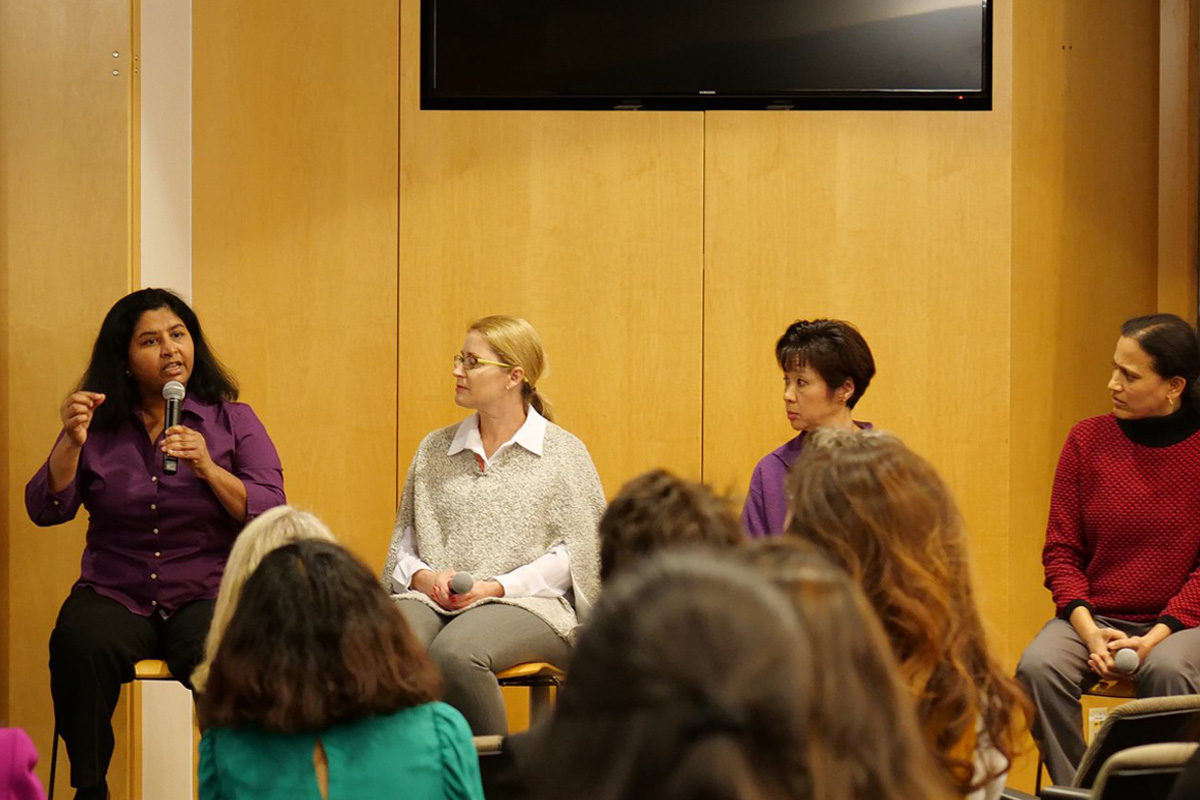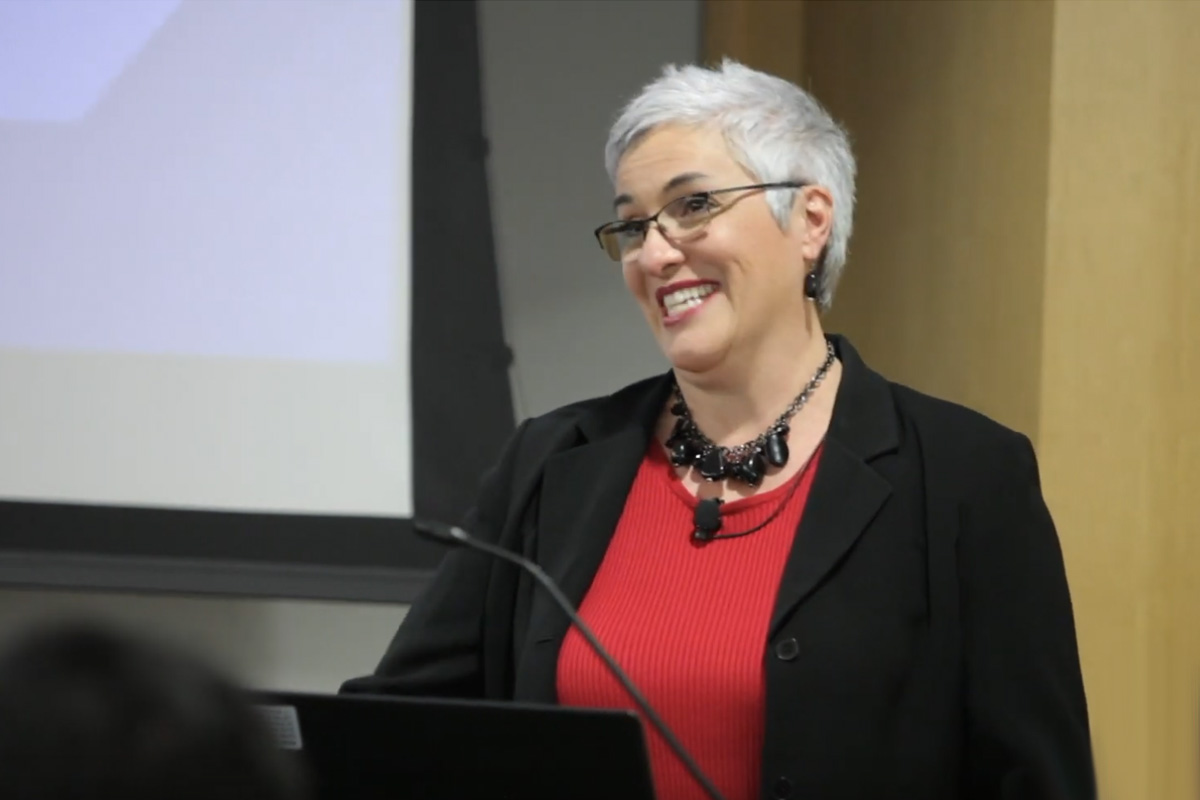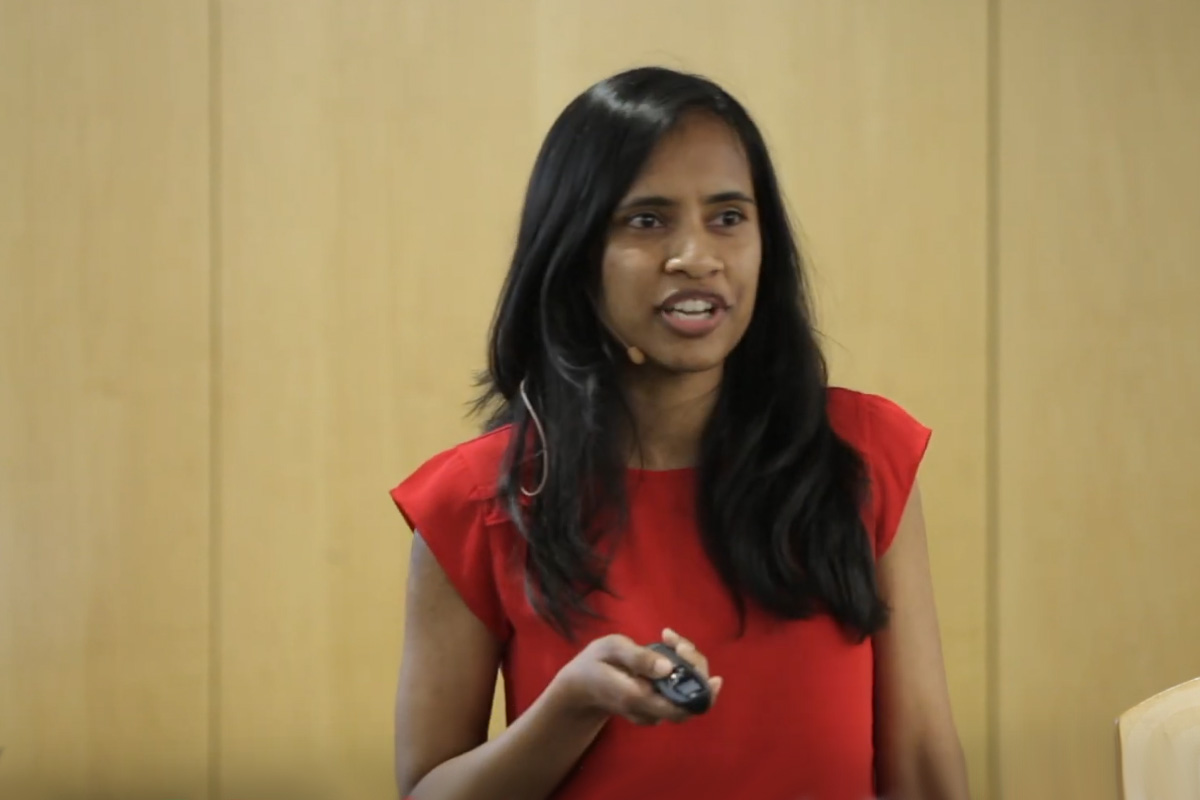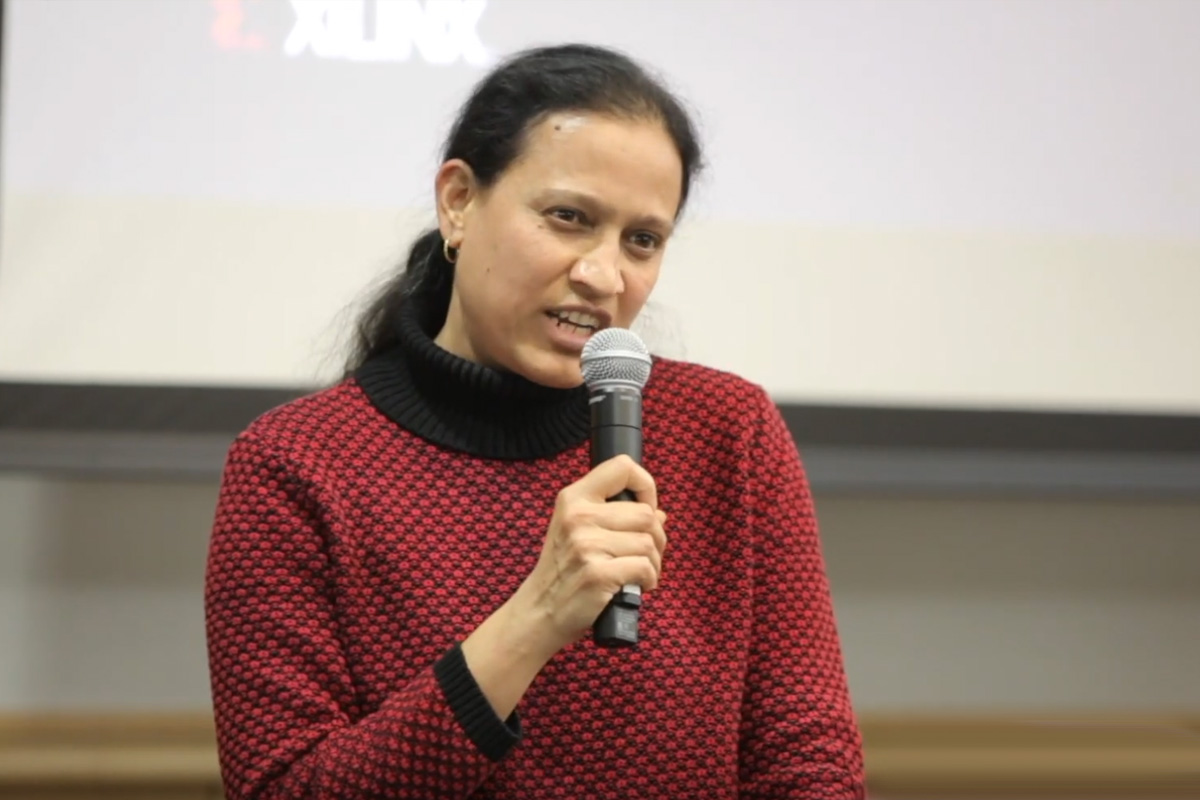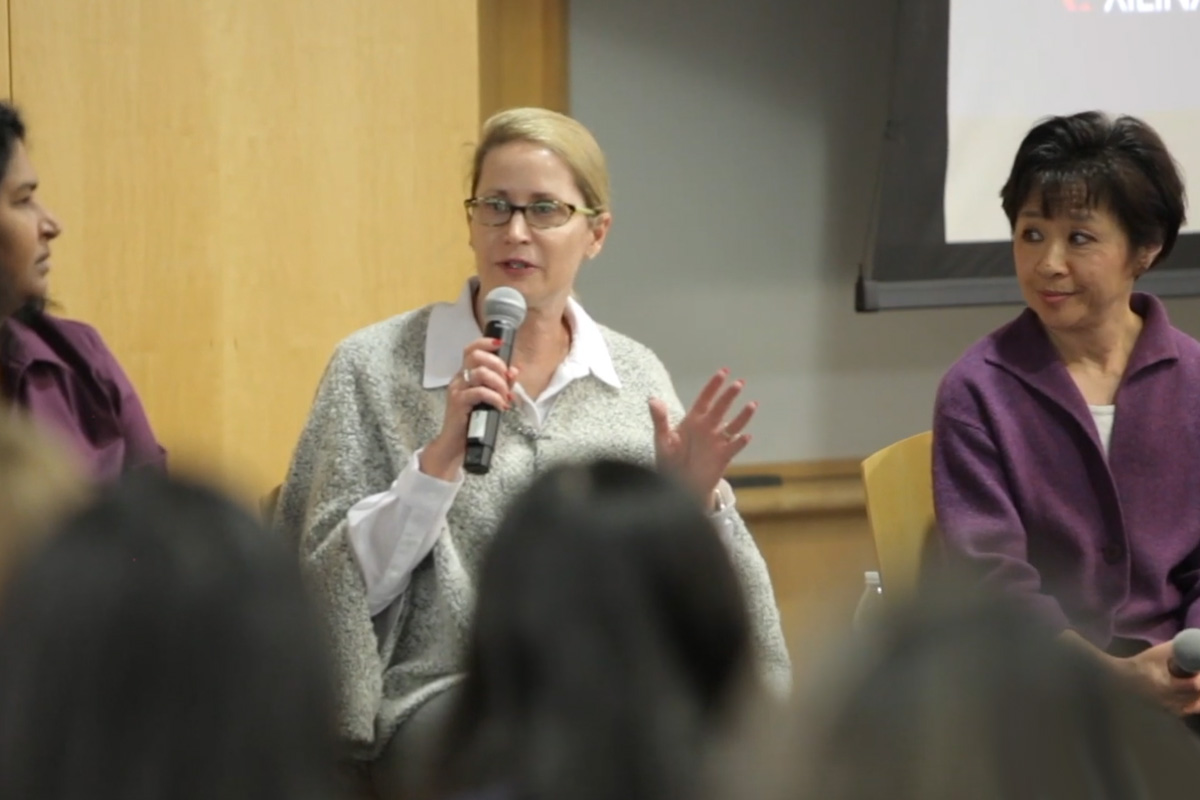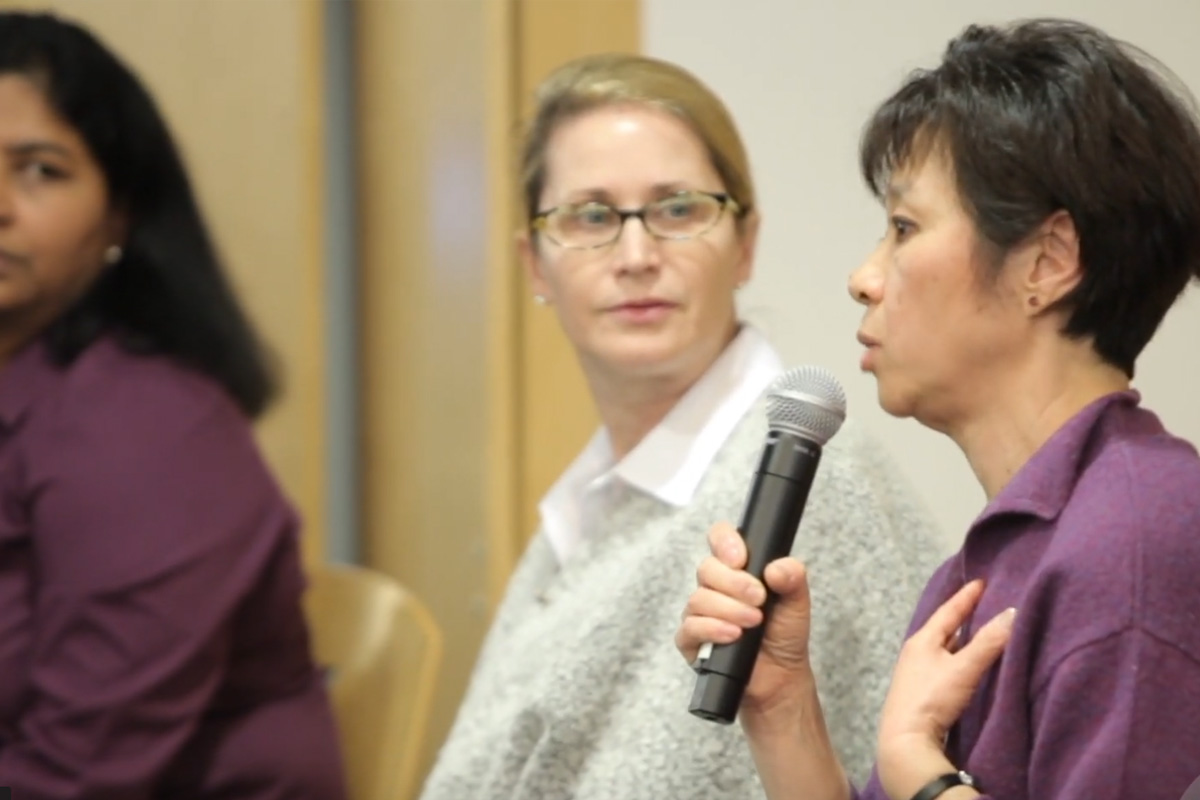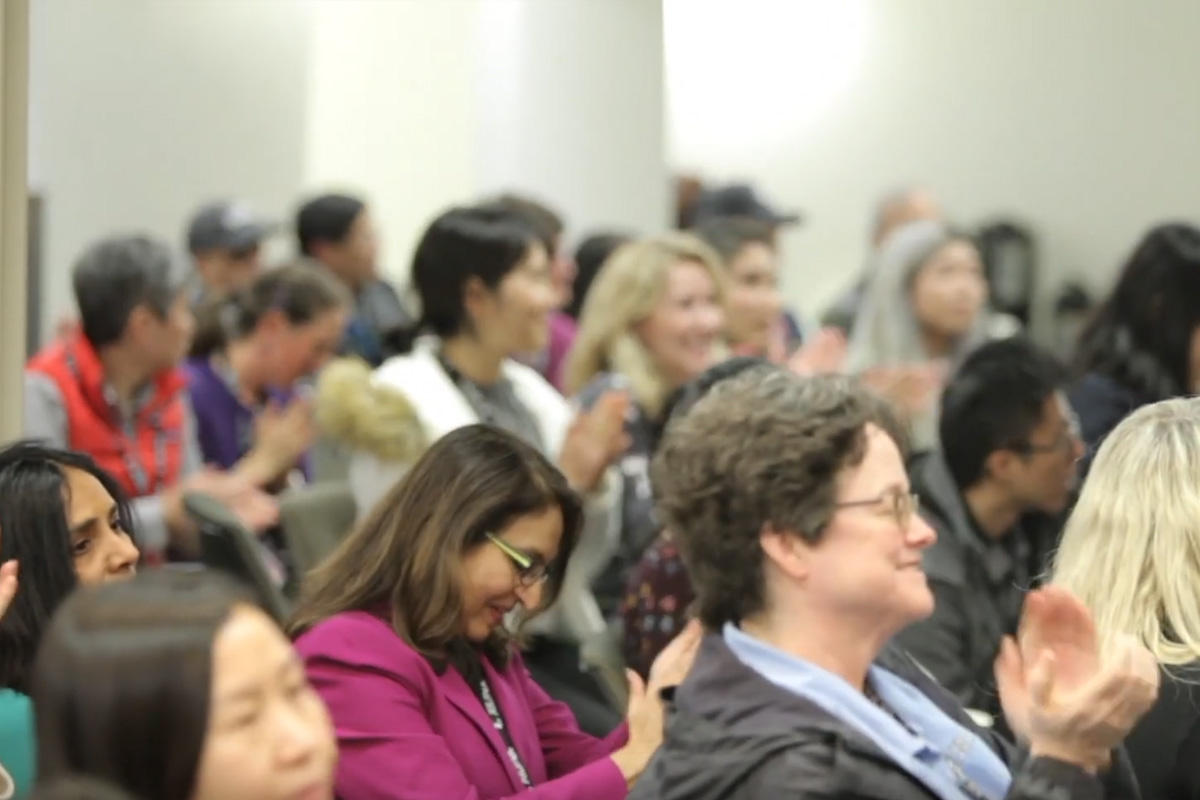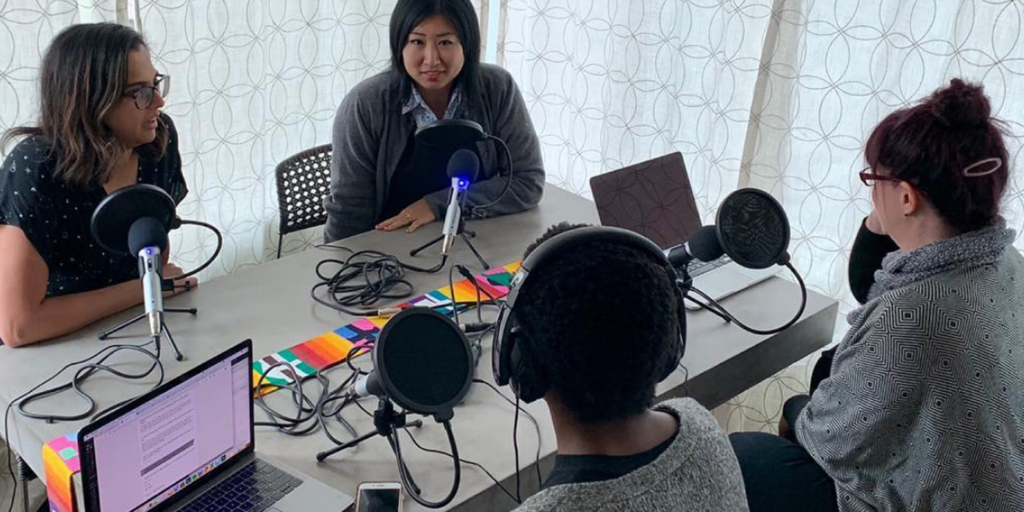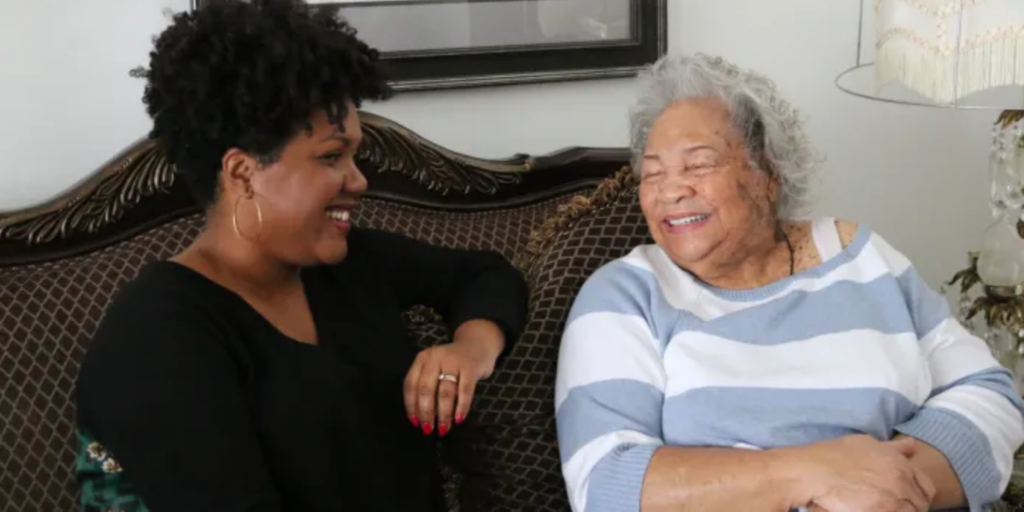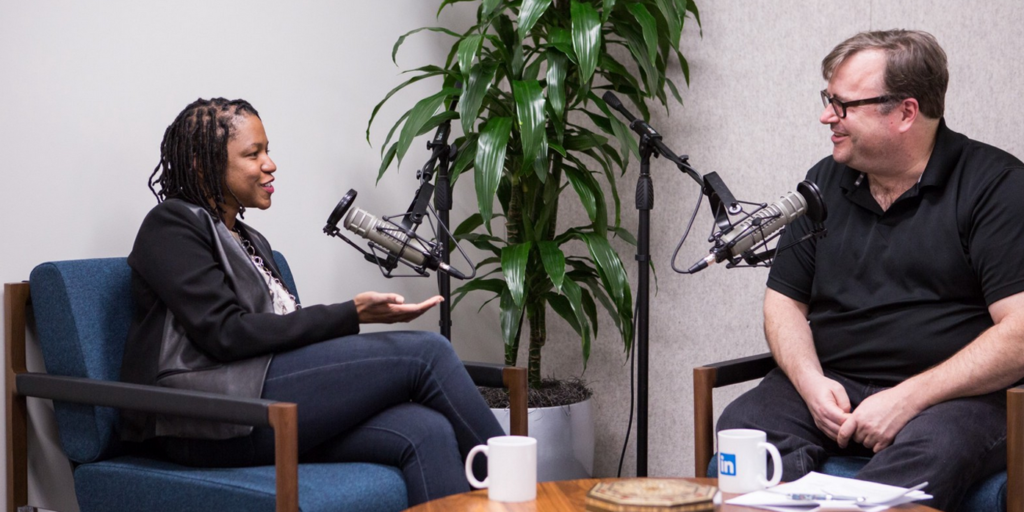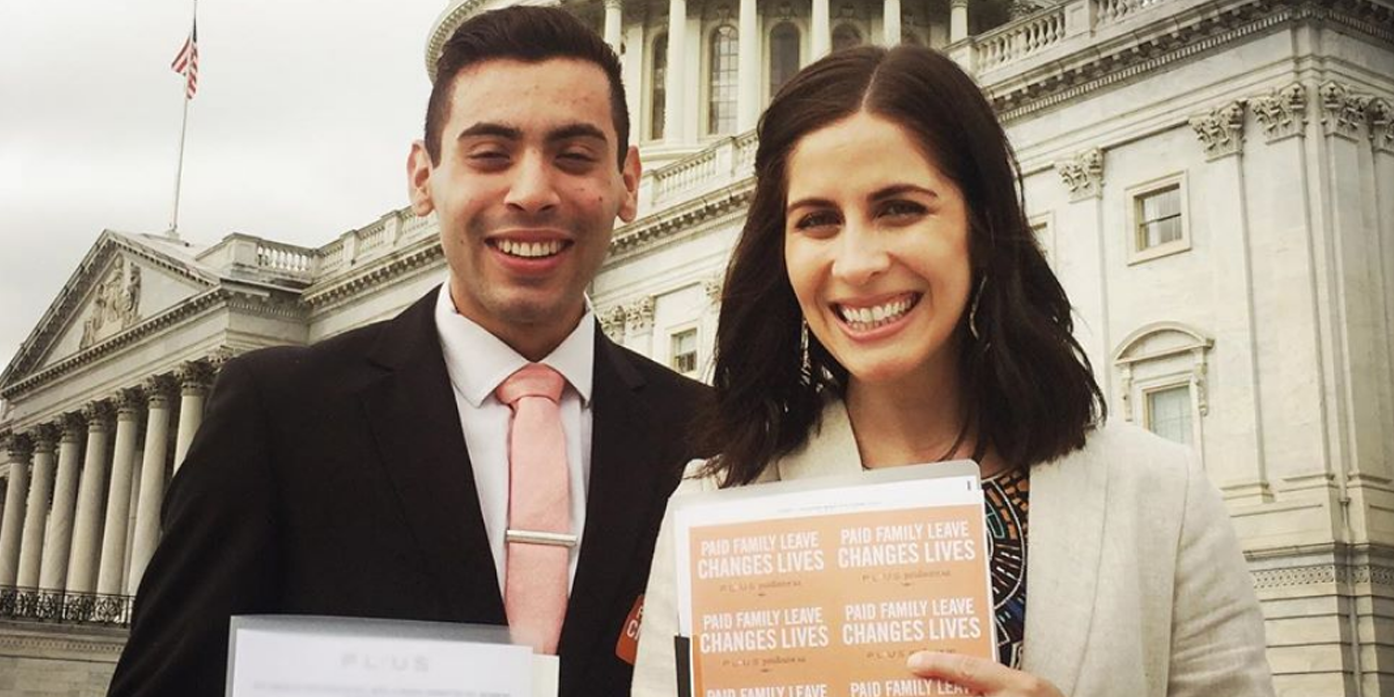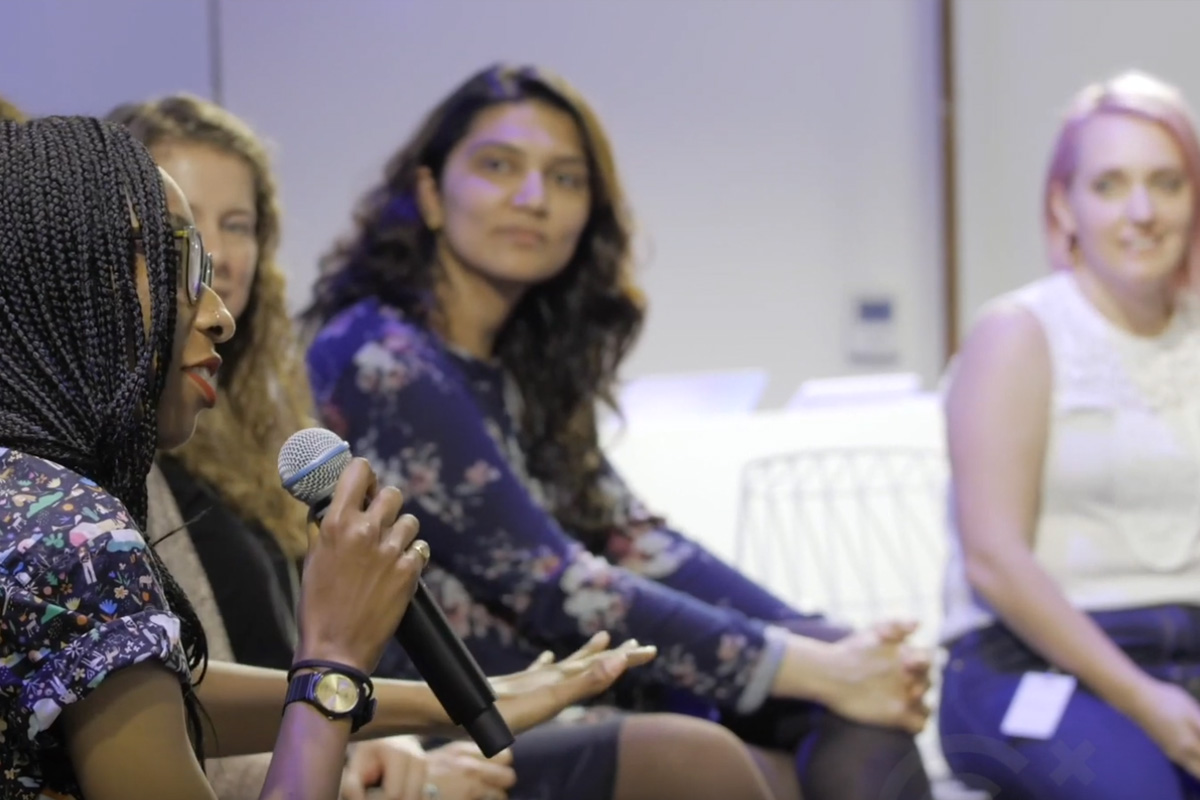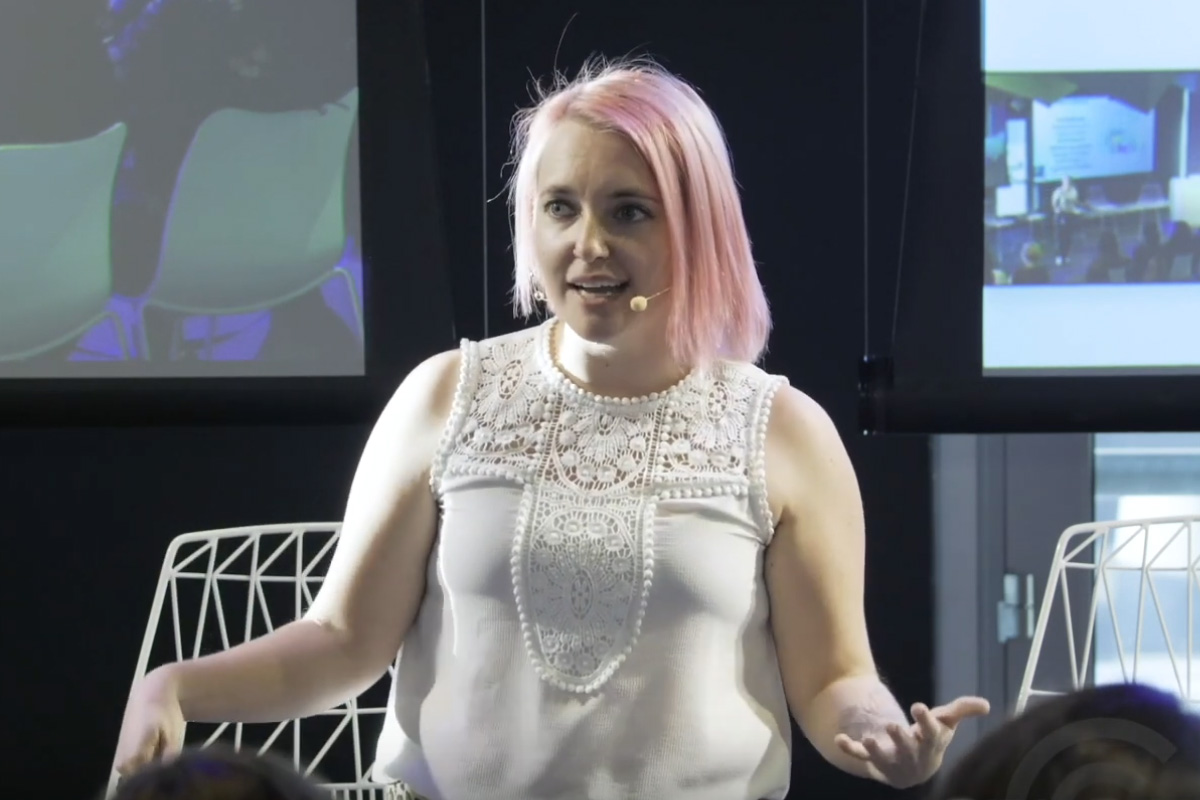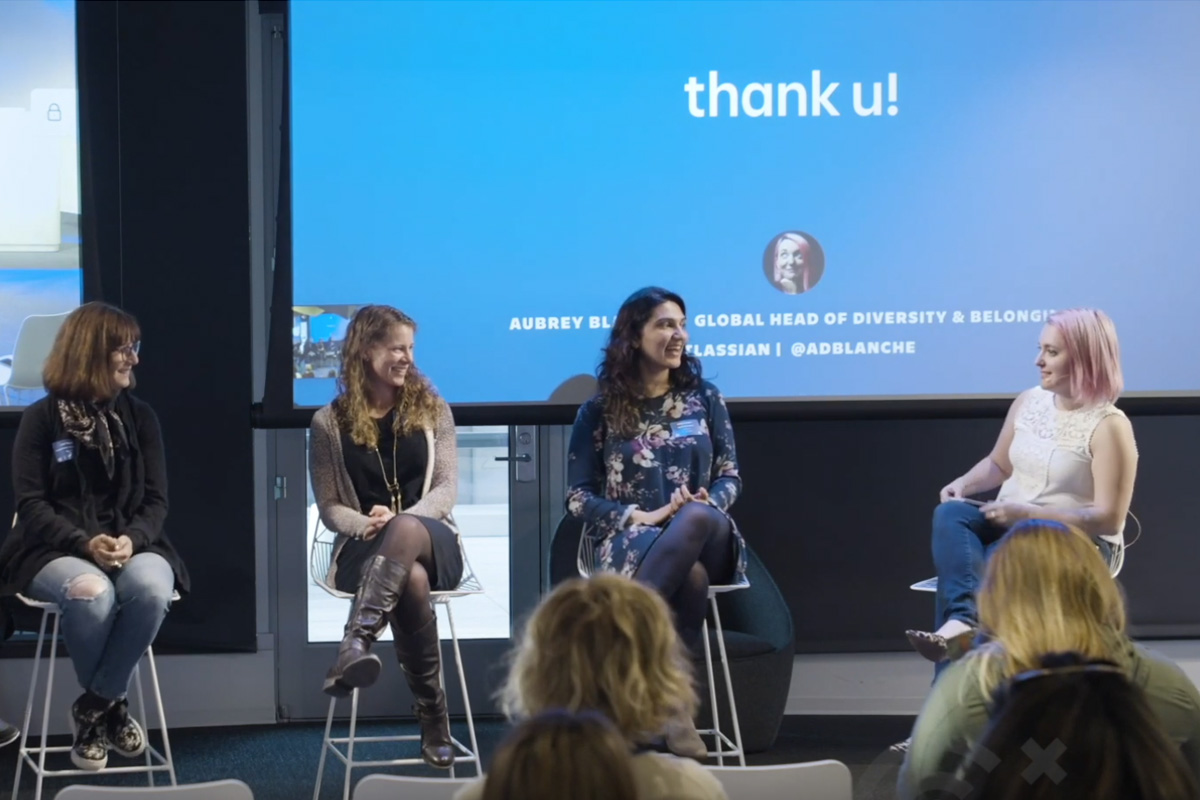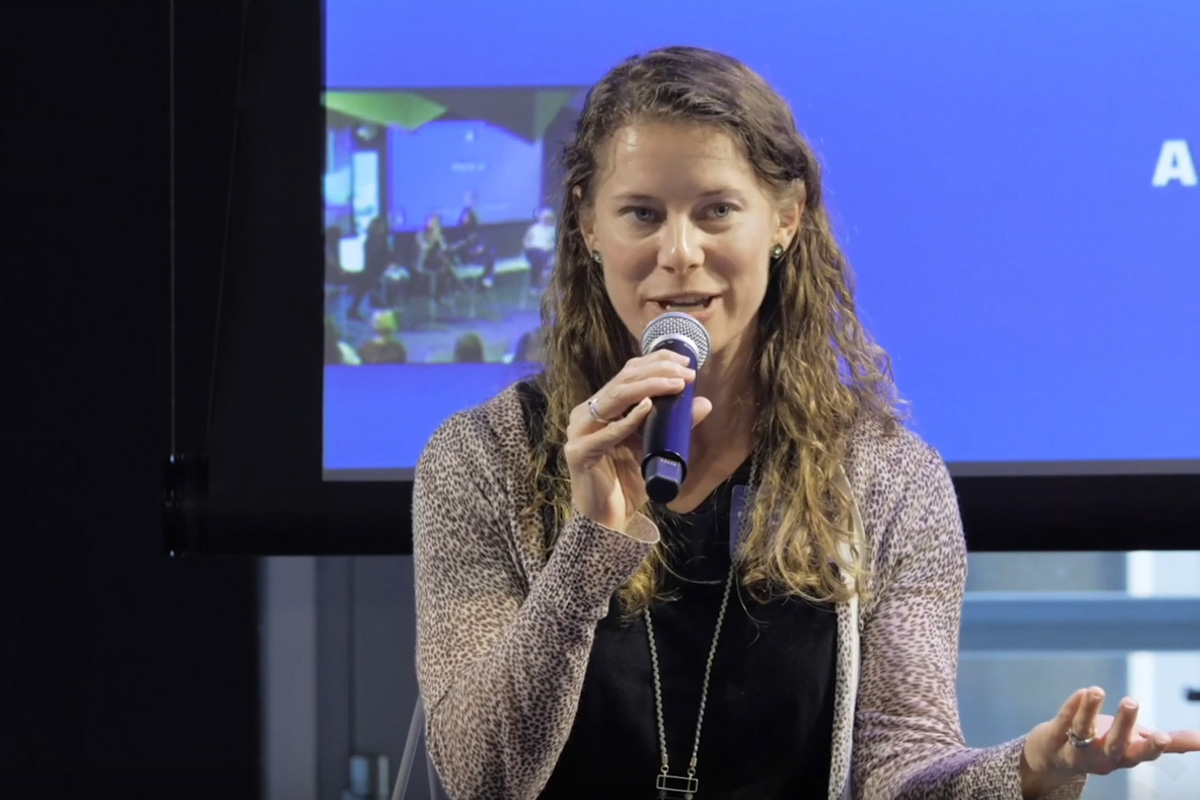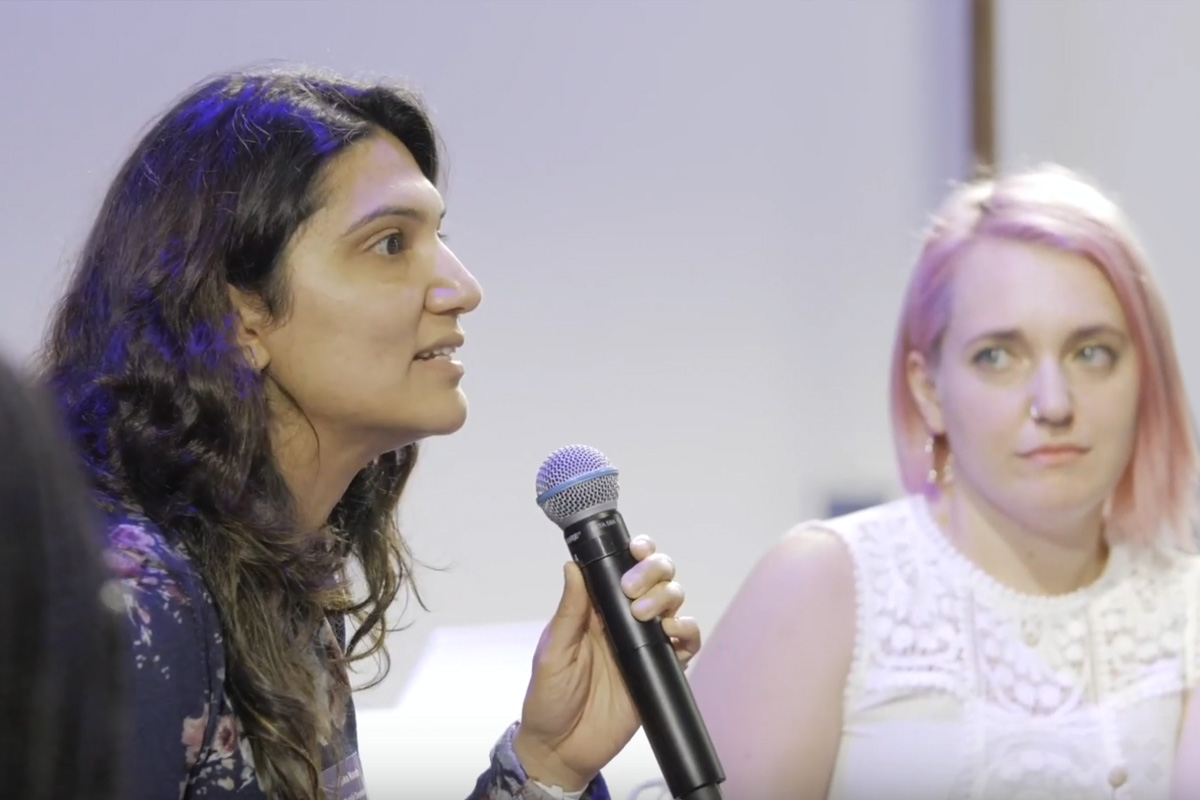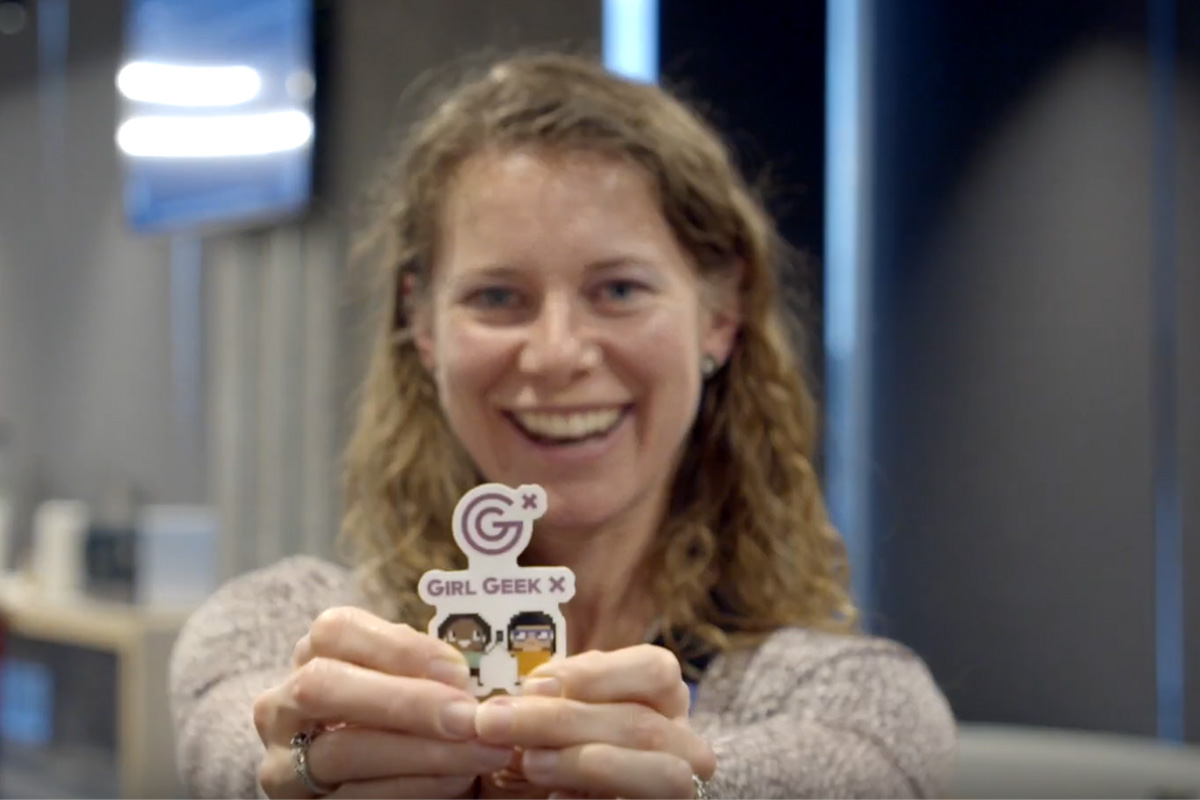Like what you see here? Our mission-aligned Girl Geek X partners are hiring!
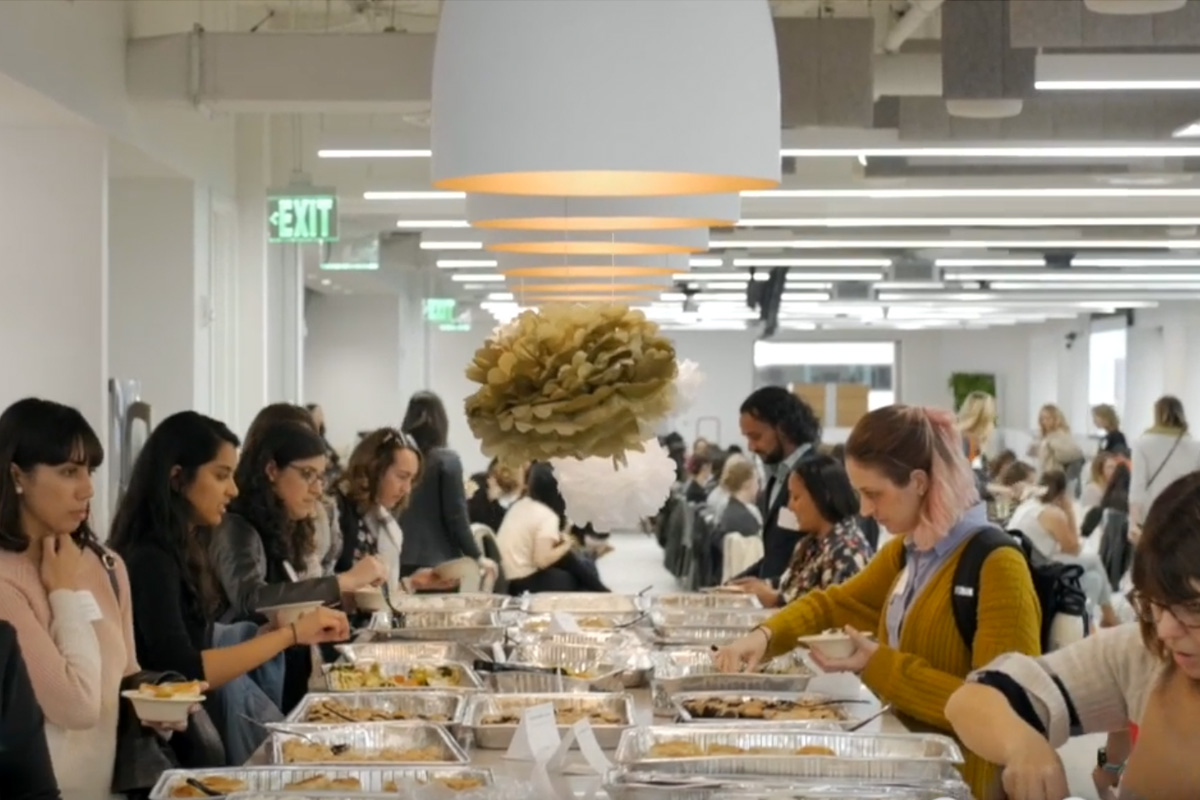
Hundreds of girl geeks came to Stitch Fix Girl Geek Dinner for the food, drinks, good company and excellent talks from CTO Cathy Polinsky to Principal Software Engineer Erin Dees.
Speakers:
Cathy Polinsky / CTO / Stitch Fix
Emma Colner / Software Engineer / Stitch Fix
Lila Bowker / Product Manager, Engagement / Stitch Fix
Anna Schneider / Data Science Manager / Stitch Fix
Erin Boyle / Data Scientist / Stitch Fix
Bingrui Tang / Senior UX Designer / Stitch Fix
Erin Dees / Principal Software Engineer / Stitch Fix
Angie Chang / CEO & Founder / Girl Geek X
Gretchen DeKnikker / COO / Girl Geek X
Sukrutha Bhadouria / CTO & Co-Founder / Girl Geek X
Transcript of Stitch Fix Girl Geek Dinner – Lightning Talks:
Angie Chang: Hello! Awesome. Thanks everyone for coming out to Stitch Fix tonight. My name’s Angie Chang, I’m the founder of Girl Geek X. It’s been 11 years of hosting weekly dinners at companies around the Silicon Valley in San Francisco. I want to thank you so much for continuing to come back, and also if it’s your first time, I hope you’ve met some amazing people. I learn something new every time, when I come to another one of these events. This is Stitch Fix’s second time hosting this event, and it’s really great seeing them grow, and I’m really excited to hear them speak again.
Gretchen DeKnikker: Hey, I’m Gretchen. How many of you guys are wearing like your Stitch Fix stuff today? Yes. I made sure that I had on all my stuff, and I feel really cute, and I have to say you guys look extra cute. Like you always look cute at the events, but you look extra cute tonight. I can tell. Okay, so how many people is this your first time? Whoa, a lot. Okay. So we actually do these every single week, so make sure you’re on the mailing list, and the next one’s at Cisco, and there’s a few more in the city, Intuit, like there’s a whole bunch of really awesome ones coming up.
Gretchen DeKnikker: We do have a podcast also, so find that on your favorite station. We just did one on uncommon unconventional career journeys, which is a fun topic. But we do mentorship, imposter syndrome, like all of these, so check it out and give us some feedback. Read it, tell us what you’d like to hear about. Tell us how we can be better. And Sukrutha.
Sukrutha Bhadouria: Thanks. Hi everyone, I actually did try wear my Stitch Fix pants, but they don’t fit anymore.
Speaker: We have maternity.
Sukrutha Bhadouria: You do, you have maternity? Okay. I did not get that notification. Thank you. No, but, anyway, the clothes are really cute and fun, and the last time when Stitch Fix sponsored, they spoke about how they used data to correctly identify the styles and the sizing that you need, and it just really blew my mind, how you think, “Oh, I’m just getting clothes in the mail.” But there’s so much thought and engineering and data that goes into it that shouldn’t go unnoticed.
Sukrutha Bhadouria: Speaking of data, we’re also trying to get a sense, so if it’s your first time, how many of you are going to sign up for our mailing list? That’s-
Gretchen DeKnikker: You can decide later. Like we haven’t proven anything, other than that they can get you good food.
Sukrutha Bhadouria: Yeah, but I do want to say it’s really easy to sign up for our mailing list. Go to girlgeek.io, and there’s like one click and you’re in. I do want to say Cathy is my absolute inspiration. We do podcasts, and we also do virtual conferences, and the first time we did a virtual conference she was kind enough to agree to kick it off and do the keynote. And so even that audio and video is available on our website, you can easily access it, and also on our YouTube.
Sukrutha Bhadouria: So enough from me, because there are great talks coming up, and Cathy is going to kick it off. I know Cathy, because she used to be at Salesforce, kicking butt there. And she’s kicking butt here. I’m going to hand it off to you, Cathy. Thank you so much for hosting again.

CTO Cathy Polinsky talks about the company’s product, the people, and partnership at Stitch Fix Girl Geek Dinner.
Cathy Polinsky: Thanks. Thank you guys. Great. Thanks for giving us the opportunity to host. I really appreciate the organization, Geek Girl X, and the mission of really bringing together women from all over the Bay Area to connect, and to network, and to share our experiences. So thank you all for coming here, and especially welcome to people who are coming to their first Geek Girl event.
Cathy Polinsky: How many of you have never used Stitch Fix before? Yay, awesome. Well, you all have gift certificates, and so hopefully you’ll give us a try. But Stitch Fix is an online personal styling service, so we’re disrupting how people can find things that they love, and our mission is to help people feel and look their best. The way that we do this is we pair human stylists with data science to help people discover their looks.
Cathy Polinsky: And so, I mean many of you have tried to buy clothes online, it’s a pretty miserable experience, and what we’re doing is first you fill out a style profile, similar to a dating profile, but about things that you like to wear. We then use dozens of machine learning algorithms to get match scores against all the items in our inventory. We send those match scores to our stylists, and we have over 4,000 stylists who work for us.
Cathy Polinsky: These are employees of ours. We feel really passionate about not replicating the Uber gig economy of contractors, but really these are employees of ours who work from home, and are really passionate about serving our client’s needs. They hand curate a Fix just for you. They pick the clothes, they send it to one of our fulfillment centers. We put it up in a nice box, we send it to your house. You get to try it on at home. You keep what you like, you send back the rest. We pay for shipping both ways.
Cathy Polinsky: The great thing about our model is that we get better and better the more we get to know you, and you share data about what you like, and what you don’t like, and that gets fed back into our model. And so we’re an eight-year-old company, and proud that Fast Company named us one of the most innovative companies last year. Woo! Thank you.
Cathy Polinsky: This is Katrina Lake, our CEO and founder, and I feel really passionate about working for a female led company. She is a really amazing entrepreneur and leader, that I really get so excited every day to get to work with her. It’s a very data driven company, led by a very data driven leader. That really goes into the innovation of what we do.
Cathy Polinsky: We’re eight years old, we’re a newly public company, making over a billion dollars in revenue. We’re profitable. We’ve got business lines for women’s, for men’s, for kids, for plus, maternity. We’re just about to launch our first international company in the UK, so look for the announcement soon. If you know anyone in the UK, let them know once it’s launched and we’d love to have them try out our service.
Cathy Polinsky: I really get excited about our business model, and it’s just very interesting to deal with something that has a tangible product, and a huge operational aspect. I’ve worked at companies like Salesforce and Yahoo and Amazon, and this is just a different aspect of how I’m working with technology, with our tech teams.
Cathy Polinsky: It’s also really amazing what a strong engineering culture we have, and company culture. We have what we call the Stitch Fix OS, it’s our operating system for how our teams work together. And I think it’s really great to be able to work for a company where you can see the values that you have, aligned with how we run ourselves as a company.
Cathy Polinsky: Two things that really stand out to me as a technologist, is one is our value around authenticity. When I started my career as a software engineer all I wanted to do was fit in and look like one of the guys. I didn’t want to stand out as a woman. I wore baggy T-shirts and jeans, and just wanted to be treated as a great software engineer, and to be respected for what I did, rather than stand out as someone who is different.
Cathy Polinsky: There’s a lot of overload that goes in your brain to just try to fit in, to just try to fit in the same box, talk like one of the guys, to play the first person shooter games, or whatever it is that we were doing back then. It is a little exhausting to think about trying to fit in, instead of just getting to work, focus on your work.
Cathy Polinsky: Stitch Fix is a company where we are trying to help people look and feel their best, because we feel like that they can go out and lead more confident lives, and just the feeling you have when you’re wearing that great outfit and being able to be yourself really matters. We also have a mission for our employees to do their best work, and a lot of that comes down to being their authentic self. So not having to feel like they have to double check their email three times, or phrase things to seem less emotional, or more powerful, or whatever codified words that it might mean to kind of fit into that mold.
Cathy Polinsky: And so we have authenticity as one of our Stitch Fix values, of letting everybody be themselves, and thinking about the culture additive that brings to the organization, so that people can focus on their work instead of just trying to fit into the mold.
Cathy Polinsky: Then the other thing that we have a really strong value is around partnership, so it’s a complex business model that we have. First it starts with the merchandise. We own all of the inventory in our system, that we’re selling to our clients, and if we don’t buy the right inventory, and the right quantities, we’ll never serve our client’s needs. Then we’ve got this huge workforce of stylists and making sure that they have all the tools that they need to operate at their job every day.
Cathy Polinsky: Then we have a huge operational aspect of how we get those products to the clients in the right way, and manage all of our inventory and our costs. And then we have this whole business with our website, the style profile, and engaging products that want you to come back to our site every day, so that we can get to know you better and better.
Cathy Polinsky: If you think about all those aspects, there’s … I’m always surprised by how little changes on one side of those have deep impact on other sides. We could make some changes to how many items we send in a Fix, and that could change the inventory allocation that we have available for the next person. And so it is one of the most partnership driven companies that I have worked for, in that you really have to think about not just your own area, but how that could have an impact across the company.
Cathy Polinsky: We thought what’s really interesting about our business is how strong of an EQ we have here at Stitch Fix, and how that has really led to our innovation and success as a company. And that we really strive for that when we’re hiring technologists, so people who can think not just about building something to spec, but really thinking about understanding the business model and how they can work together across different lines. Whether it’s a data scientist working with an engineer, or someone of the design team working with our marketing team.
Cathy Polinsky: And so we’ve got a theme today of partnership that we’d like to share with you. Talking a lot about some of the interesting projects, but really leaning into how you can use that aspect of your skills to really be a big success. I’d say one of the things that I learned about partnership came from a big misstep, I would say, as an early engineering manager. So going back to this feeling of authenticity, you only know what you see, and so being in an organization where I saw mostly male leaders, I tried to emulate a lot of them in my leadership style. It didn’t always feel comfortable, but you just try to do the things that you’ve seen to be successful when you run into tough trouble.
Cathy Polinsky: A few companies ago I was working on a project, and my team was getting pulled in different directions, and I felt like, okay, I’ve seen the way that guys handle this, and they pound on the desk, and they really fight for their teams to make sure that they’re not being jerked around, and that they’re getting the staffing and the support that they need. And so I tried to do the same, and I pounded on the desk, and I yelled in meetings, and I said that this was just really unacceptable for how we could get something done.
Cathy Polinsky: And it didn’t work, and I kind of failed miserably at making the changes that were really needed to work on this project in a way that was getting clarity on the architecture and the designs needed at a large scale. It was like, I don’t understand why this isn’t working, it works for other people, I’ve seen managers do that in the past. But I have to say, I had some self-reflection, it didn’t feel good to yell in meetings. It wasn’t successful and it wasn’t me, and it just made everybody really miserable in the process.
Cathy Polinsky: And so the next time I went to a new company, I was like, okay, never again, I’m not going to try to be someone I’m not, and to try to get through this with anger and yelling. I’d say that I learned a lot in my next role, of really starting to build relationships. So how can I build relationships upfront, build trust, so that when we have difficult situations, instead of it getting to a point of anger it came to a conversation. I found that I really developed my leadership style, because I leaned more into my authentic self and led into building partnerships. Because I think that when you have those partnerships, you can get a lot more done.
Cathy Polinsky: I see that here every day at Stitch Fix and hope you’ll see some great learnings around partnerships that we have here today with some of our speakers. So without further ado, our theme is around technology and partnership, and we’re going to pass it off to Emma. Yeah, Emma, come on up. Where’d she go? There.
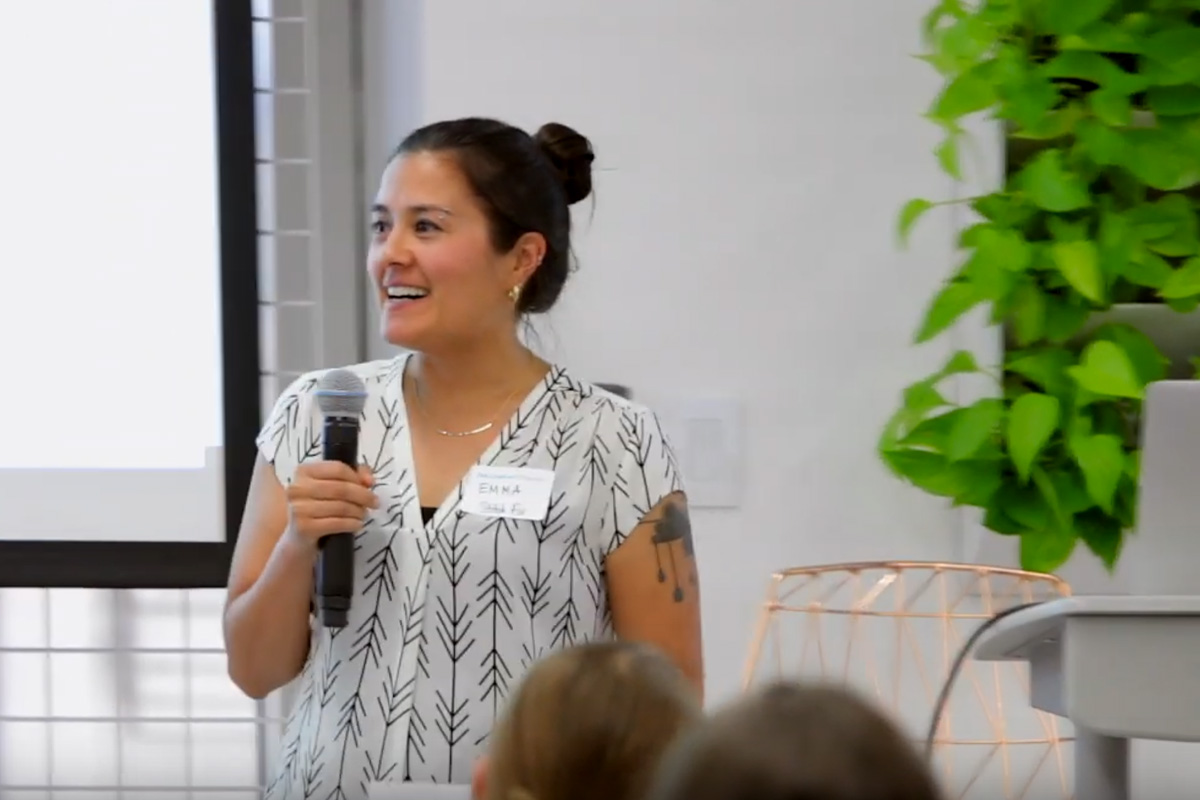
Software Engineer Emma Colner gives a talk on “Mind The Gap: How Our Brains Fool Us into Thinking We Understand” at Stitch Fix Girl Geek Dinner.
Emma Colner: I don’t know if you want your wine that’s up here, Cathy. All right. Hi everybody, my name is Emma Colner. I’m an engineer here at Stitch Fix, and I work on expert use systems. That means I build tools for my co-workers that help them do their jobs more efficiently. But in a previous life I was also a former experimental psychologist, so I really enjoy thinking about thinking, and today I’m going to be talking about how experts think, and how that differs from how novices think, and the different implications that can have for when we are collaborating together at work. Oh.
Cathy Polinsky: I stole this.
Emma Colner: Thank you. I only have two hands. So I’m just going to hold this. Okay. Like Cathy was saying, we value partnership a lot at Stitch Fix, and I think it makes a lot of sense to really try and understand how we can bridge this gap between how experts think and how novices think, and what they know. But also it’s a great opportunity for us to harness each individual person’s expertise. In that way we can kind of learn and grow together as a company.
Emma Colner: To start, I’d like you to think about someone that you really admire, someone whose skills and knowledge you really look up to, and someone that you might want to emulate one day. Imagine that this building here on the left is a representation of all that person’s knowledge about a certain topic. Now, if you were to learn how to do what this person does, how would you do it?
Emma Colner: Well, you could try and just copy what you see, but you could also … You’re not even sure of whether the building is going to be structurally sound, so what we don’t see is that this building started out as an idea, and a series of discussions, and lots of back and forth plans before there was even a foundation built. What I’m trying to say is that basically when we look at an expert we don’t see the path that they took to get to where they are.
Emma Colner: We don’t see all of the hypothesis that they tried and tested. You don’t see all the doubt that they experienced, so it’s just important to keep in mind. Part of what makes being a good partner a challenge, is that it’s impossible to truly know the experience of someone else. We can be excellent observers, and we can infer a lot about someone just by looking at them, but we don’t know everything. Part of the difficulty is that as people we naturally just fill in the blanks. When we don’t know something, we infer based on stuff that we already know.
Emma Colner: In some situations this can lead to some false understanding, so to succeed at partnership we need to work hard to bridge that gap between minds. I included this quote here on the right from Domain Driven Design, by Eric Evans, just because I thought it was relevant to what I’m talking about today. I’m not going to be talking much more about it, but I’m still in the middle of reading it, but it was a really good introduction. I recommend it.
Emma Colner: For now, I’m going to be describing three different scenarios that I have experienced in my software engineering career, and what they can teach us about our brain’s natural limitations, so we can become better communicators, problem solvers, and business partners.
Emma Colner: In scenario one I’m a junior software engineer, I’ve just started at Stitch Fix, and I have a mentor who’s a principal engineer. We pair pretty much every day, and half the time I don’t know what he’s talking about. He’s speaking in a different language, and also I don’t even know how to phrase the questions that I’m trying to ask. I don’t know how to phrase the search terms that I want to put in Google to understand what I’m trying to do. So that’s the first scenario.
Emma Colner: Second scenario is, in this scenario I’m the expert. I built something, I built a new feature, I’m trying to get it to work, but there’s a bug that I just can’t figure out. I’ve spent many hours on this, and finally I decide to ask someone for help. But then as soon as I explain the issue to that person, the answer just kind of pops out at me, and the other person didn’t have to say a word.
Emma Colner: And then the third scenario, collaborating with business partners. So let’s say I’m working on a new feature with my business partner. We’ve met and talked about the project several times. We meet each week, seems like we’re all on the same page, but at some point it becomes obvious there’s been some kind of miscommunication, and the project doesn’t end up as we had expected.
Emma Colner: What do all these scenarios have in common? Well, they all demonstrate a gap between what we as experts think we understand and what we actually understand of someone else’s domain. When experiencing cross-functional teams, this difference in expertise can cause friction and lost productivity. I want to advocate for a solution of adopting a beginner’s mindset. So now the neuro scientist is going to come out of me, and I’m going to have a very, very simplified explanation of how learning works in the brain, and how differences in expertise can lead to different outcomes.
Emma Colner: When we learn something for the first time it’s an effortful process that takes a lot of mental resources and attention, so that’s what those red scribbles represent. Over time, as we change from novices to experts, our brains become more efficient as memories consolidate, and unnecessary information is forgotten. The representation of information shifts from the sensory regions to cortical regions of the brain that operate more heuristically and more efficiently. That’s what all the green squiggles are meant to represent.
Emma Colner: So the more knowledge you have on a topic, the more associations you have built up in your mind, and the greater the network of brain areas that are involved while working on a problem. What do I mean about our brains becoming more efficient? I’ll share with you a study called The Development of Expertise in Radiology, and they basically showed that expertise can reduce the complexity of the environment. They did this by showing chest radiographs to novices and expert radiologists and they tracked their eye movements.
Emma Colner: They were told to detect some kind of an anomaly. You can see on the left that … The red represents more time looking at a certain spot, and green is less time. What we see is that novices are just kind of looking all over the place. They don’t know what they’re looking for. They’re spending a lot of time just kind of lost, whereas the experts, it seems that their attention is automatically drawn to the important aspects of the image.
Emma Colner: So that actually, the knowledge that they’ve had over their experience has helped reduce complexity and made the problem easier to deal with. Novices, on the other hand, are using more rudimentary tools. They might take longer, or it might be harder to solve the same problem. Most of the time being an expert works to our advantage, saving us time and energy, but in certain cases, like in the three scenarios I talked about earlier, it can be a handicap.
Emma Colner: Why might that be? Well, the price of expert efficiency is that the scaffolding, or the context surrounding when you first learned something, has been forgotten, probably by the time you’ve become an expert. So just as your brain actively consolidates memories it wants to keep, it forgets most of our daily experience, so over time we only remember the important stuff. Sometimes the only way around a problem is to work through it from the bottom up, starting with basic concepts and building up your understanding, rather than starting from an existing mental model and working down.
Emma Colner: That way we’re forced to think more deliberately, which helps expose weaknesses in our logic, and in other words it helps to just adopt this beginner’s mindset. Circling back to the different scenarios, on the left, that represents my mentor. He was working with a full-fledged Lego set with pieces that all fit together in a sequence that makes sense. And that’s actually like Legos. Whereas I, on the other hand, was working with a bunch of wooden blocks and playing around, trying to stack one idea on top of another, hoping it doesn’t fall down.
Emma Colner: I think what might have happened with my mentor is maybe like he had lost the scaffolding, he had lost the context of when he’d first learned a certain topic that he was trying to explain to me, and so it becomes harder to kind of connect with someone who has such a different skill level.
Emma Colner: And then in scenario two, I was basically describing rubber ducking, which is a debugging method where you basically explain your code to some inanimate object. It doesn’t matter what you explain your code to, but it’s surprisingly helpful in letting you know what it is that you’ve done wrong. The reason it’s so helpful is because you’re forced to approach a problem from a different perspective. You’re building up and filling in the scaffolding that you had lost previously, and that can help us gain some new insights.
Emma Colner: And then in Scenario three, when I describe how I’m working with my business partner, where we didn’t fully connect on our vision, what happened was we both had like a false understanding of the problem and/or the solution. We’d both made some kind of assumption about each other’s work without even thinking about it, because we were both experts in our own domains, and our brains are filling in the details of things that we might not understand fully.
Emma Colner: So, yeah, really, this picture is a joke, but it just demonstrates how easy it is to misinterpret things that might seem really easy. Lastly, I just wanted to return to the skyscraper and reconstruction metaphor for mental models. So while it’s being built up, there’s scaffolding all over the place, allowing workers to place one brick on top of another, but when construction is done, the scaffolding is taken away and all that’s left is a perfect shining tower.
Emma Colner: It can be hard to remember how we arrived at a conclusion once the scaffolding is gone. The next time that you’re collaborating on a project with someone of a different background, remember that you don’t see the path that they took to get to where they are, and it’s often necessary to spend the time to translate, describing one person’s solution in a language the other person understands. Or better yet, coming up with a common language together. Thank you.
Lila Bowker: Thanks Emma. Hi, my name’s Lila, I think I met most of you when trying to sort out the name tag situation up front. I’m just here to make the transitions less awkward, but there’s no guarantee that that’s actually what’s going to happen, so I have notes. Thanks, Emma, for the reminder of how continuous learning and kind of taking a beginner’s mindset is incredibly important as we work with our cross-functional partners.
Lila Bowker: Next up we have Anna Schneider. She’s a manager on our merch algo’s team, and she’s going to talk about how she partners with experts in merchandising to help make our buying better. I’ll give you that. Oh, you have LaCroix. How are you going to switch slides with LaCroix?
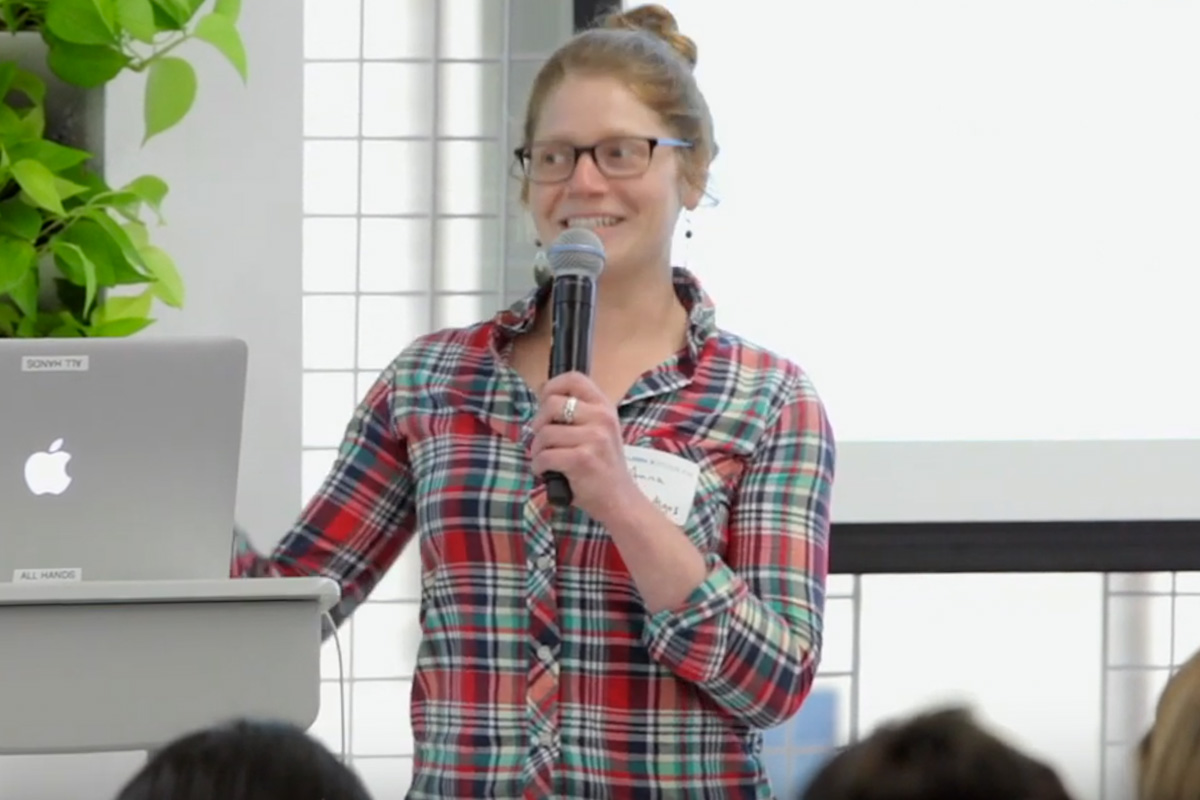
Data Science Manager Anna Schneider gives a talk on “Transforming the Way Merchants Find What They Love” at Stitch Fix Girl Geek Dinner.
Anna Schneider: I’m going to put it down, is what I’m going to do. Hi. Yeah, so I’m Anna. As Lila said, I’m a data science manager here. I’m going to talk about a project that I worked on that is very similar to the scenario three that Emma was just talking about, where you’re working with a cross-functional partner, and you think that you’re solving the same problem, and it turns out there’s a whole different kind of problem, and a whole different kind of solution that was needed.
Anna Schneider: So when I say buying better here, I’m not talking about how clients buy better stuff from Stitch Fix, I’m talking about how buyers who work at Stitch Fix buy better stuff to send to clients. So digging in a little bit more, we have a team of people called buyers who are Stitch Fix employees, and their job is to figure out what we should be stocking in the warehouses. That determines the pool of merch that then the stylists can choose from when they’re deciding what to send to a particular client.
Anna Schneider: And upstream from the buyers, the buyers work with vendors to figure out what they should be stocking. So by working with the right vendors and buying the right things from the vendors, the buyers have a huge influence on the end experience that the client’s have, by making sure that we have really good stuff in the warehouses. That’s going to be good no matter who shows up as a client who wants a Fix.
Anna Schneider: If you think about what the buyer’s day would look like, an old school company or at Stitch Fix in the early days, this is what a buyer would do. They would look at a list of things that are on offer from the vendors, and because if you’re lucky to work at a place like Stitch Fix, there’s going to be some performance metrics associated with each one of these items of clothing. And so the buyers would look through a list like this, pick the things near the top of the list, and that’s what we would buy, and that’s what the clients would get sent.
Anna Schneider: This has a number of problems. One of them is that it’s kind of like a standard e-commerce experience for the buyer, so they have to like search through all these lists and hunt and peck, and decide what merch to be carrying. One of the big values of Stitch Fix is that we don’t make our clients go through that experience of doing all the e-commerce shopping themselves, so why are we making our in-house buyers go through that experience?
Anna Schneider: We thought there must be something better. And another more subtle problem with this way of buying, is that by only looking at one single performance metric, you’re only buying for the average client. So let’s dig a little bit into why this problem comes about.
Anna Schneider: Say we have these bunch of clients and we’ve sent them these shirts, and we have some performance metric for each of these. So maybe they all hate the yellow shirt, maybe the gray shirt does really well, and the two green shirts are like, nah, kind of in the middle. If you were a buyer looking at this data, you would think that, oh, the right thing to do is to buy a bunch of the gray shirt, and not buy the others. Seems good. Seems fine.
Anna Schneider: Now, what if we dig into the data and pull out some niche client segment that has different preferences than all the others. The top line shows pretty similar data to before. Those people still like that gray shirt, but the client segment on the bottom likes something else. They like the striped shirt on the end. Now if you’re a buyer looking at this data, the right thing to do is to buy both of these shirts, that way no matter who shows up there’s going to be something that’s really good for them.
Anna Schneider: And this is our mission at Stitch Fix, is to have something that’s going to be good, no matter who shows up. And so it’s really important for us to be enabling the buyers to do the job of buying a really diverse set of merch, that’s going to be really good for a diverse set of clients. So we, on the algorithms team, stepped back and thought about how can we give the buyers this data in order to make better decisions.
Anna Schneider: We thought, well, if giving them one list is bad, what if we give them multiple lists, one for each client segment. So algorithms, and engineering, and merch all collaborated to build a tool that did that. There was multiple lists, so every item of clothing would have how good is it for this client segment, how good is it for this other client segment, and the buyers would go through and choose things from the top of all the lists.
Anna Schneider: This was great. So was it going to be a better experience? We hoped so, but no. It was better at accomplishing the goal of having something that’s good for a lot of different kinds of people, but it made the hunt/peck problem way worse, because they had to dig through a whole separate list for every client segment. They were working harder instead of working smarter to accomplish this goal.
Anna Schneider: And they were like, well, we can do it with a handful of client segments, maybe, but Stitch Fix wants to get to thousands of client segments, millions of client segments, and this was never going to work. Is not a scalable solution. Something really interesting happened as we in Algorithms were talking with the buyers about all of their struggles using this tool. They started seeing some things that should have been obvious, and now that we learned them, it is things that we really care about taking into account.
Anna Schneider: They’re running a real business, and they didn’t give us this feedback in rap battle format, but they almost may as well have. So when they are thinking about what to buy, they have a huge number of other things that they’re keeping in mind, not just this one metric. In addition to having the right diversity across clients, there’s also things like having different price points, having different size and fit preferences.
Anna Schneider: We want to make sure that we really cover all of our bases in those kinds of ways. We’re running a profitable business, as Cathy said. We care about hitting our revenue and margin targets. Buying is something that happens on a seasonal cadence, and so we want to make sure that the stuff we’re buying is going to be good a few months from now. And there’s also other targets around the sort of inventory level management, so are we buying too much and we won’t be able to sell it? Are we buying not enough and there’s going to be missed opportunity?
Anna Schneider: The buyers were thinking about all of these things in their heads while using our tool, and not being able to fully actualize in their role. When we heard all this feedback, we stepped back and thought about, okay, is there a better way that we can be addressing this problem? There’s this performance metric that we want to be maximizing, and there’s all of these constraints that we have on the business. What does that sound like? And we go and like dug around in our algorithms toolbox and said, “Hey, that sounds like constrained optimization.”
Anna Schneider: So we reformulated this as a constrained optimization problem. Our decision variable is the number of units of each item to be buying for each client segment. We choose those units in order to maximize the predicted performance of the whole assortment overall. So we add all that together, as subject to all of those constraints that we talked about on the previous slide. It took a fair bit of work to formulate all of those as equality or inequality constraints, but we were able to get close enough for most of them, through a lot of partnership and talking with merch about like, “Hey, so when you want to meet this margin target what does that really mean?”
Anna Schneider: We were able to get all these formulated. To solve this we’re using a open source Python solver called Pyomo, and it’s been working pretty well for us, even though the documentation is pretty bad. If you’re interested in checking it out yourself, I would recommend googling this blog post by one of our other data scientists who is using Pyomo on a different team within Stitch Fix algorithms. It’s way clearer explanation than like anything else on the Internet.
Anna Schneider: Then in order to make this algorithm available to the buyers, we built a tool that they use to interact with it. So from their perspective, they actually specify values for all of these constraints within the tool, and then press go. And what happens then is that our algorithm, running Pyomo, combines those constraints with a separate algo’s predictions of how well each item is going to perform for each client, and spits back out the recommendations.
Anna Schneider: And so within just a couple of seconds the buyers get the whole assortment recommended returned back to them. This has been a way better experience for everyone involved. So our goal of having something for everyone, this achieves. We’re optimizing over all of the client segments at once. And something that has been really interesting to work on is that it totally changes the contract between the buyers and the algorithms, so the buyers are now responsible for having the right goals for the assortment, entering the right targets, and the algo is responsible for figuring out the best way to achieve those goals.
Anna Schneider: And so it’s almost like the experience of getting a Fix, where as a Stitch Fix client you’ll say like, “Hey, I want a cute dress for a wedding next month,” and the stylist will go off, and the stylist algorithms will go off and figure out the best way to achieve that goal for you. Now, the relationship between the buyers and algorithms is much more like that, instead of the standard old e-commerce experience.
Anna Schneider: Some lessons that I’ve learnt through this that could hopefully be transferable to some other business context, like whatever you’re working on. One is that algorithms are good at tactics, and people are good at strategy. In the old versions of this tool, the people were responsible for the tactics of digging through all the lists, and nothing within the tool was responsible for the strategy. Now we reformulated the tool so that the people are doing the strategy and the algo is doing the tactics, and that’s a much more powerful human-in-the-loop algorithm.
Anna Schneider: One important enabler of allowing people to handle the strategy, is being able to capture that strategy for the tool, and so that’s been the really interesting user experience problem, because sometimes the buyers knew explicitly what their targets were, and sometimes it was all just implicit in their head, and so that’s been a fun partnership experience too, is figuring out a good UX to tease those implicit intentions out of the users, and make them explicit.
Anna Schneider: If we were only working with collect telemetry kind of data, instead of asking like, “Hey, what do you actually want?” it would have taken much longer to figure out what some of these targets were. And last but not least, especially if you’re working in like B2B or enterprise, your users are running a real business, and their jobs are way more complicated than you realize, no matter how much time you spend getting in the weeds with them.
Anna Schneider: So in my experience, at least, it’s really worth getting into the weeds to try to figure out how their processes actually work, and then abstracting it back to something that can achieve their goals even better than they thought and you thought that could be possible. So thanks.
Lila Bowker: Yeah, thanks Anna for explaining how you use data science to make our merch buying process better. I’m going to look at my notes again, sorry. Next up we have a dynamic duo, half of which is already up here. Come on over. All right, so we have product designer, Bing Tang. Oh-oh, there goes my notes. And data scientist, Erin Boyle, and they’re going to explain how we use data to understand client style, and then how we use that to inform stylists to send better Fixes. Take it away, guys.
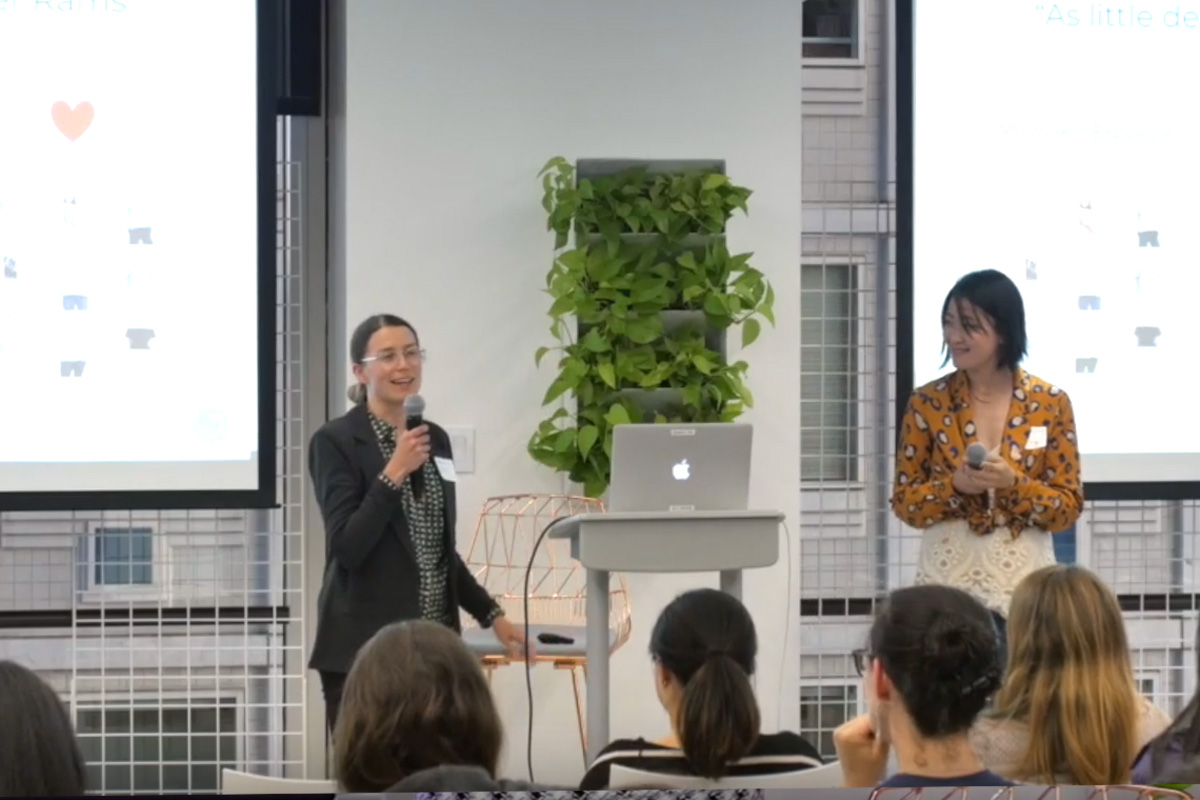
Data Scientist Erin Boyle and Senior UX Designer Bingrui Tang give a talk on “Partnering on Style” at Stitch Fix Girl Geek Dinner.
Erin Boyle: Thanks, Lila.
Bingrui Tang: Okay, hello everyone. My name is Bing, and I work on the UX design team, [inaudible]. And this is Erin, she works on the data science team and working on AI instruments, and today we’ll be … being the dynamic duo, and talk about communicating style together.
Bingrui Tang: I think Cathy already talk about this a little bit, but at Stitch Fix we really have this human-in-the-loop process. We have algorithm empowering the stylist’s work, where a stylist will actually make the call. And if we actually put our foot into a stylist’s shoes, it is a very challenging work. Imagine you have a client who is there in a 50s Fix, and their profile might haven’t been updated for a while, and their style preference has been changing over time. It is really difficult for a stylist to dig through all the things, and do we really want to empower them to use their creativity to really send a delightful Fix to our clients?
Bingrui Tang: So on the backend side, a lot of our work is really to design for the styling platform, so, as you can see here, on a platform we would combine the client data which has some basic information. Their style preference and their Fix history, as well as how the algorithm is recommending the items of a variety of categories, and decides by going through all the information about a client, they would actually be able to pick the items that they think would fit the client well, which might not always 100% fit with how the algorithm sorted out.
Bingrui Tang: So for us, a big part of our work is to make sure the way we present the client data is really helpful for the stylists, so they can really do their job well. Previously, the way we represent a client’s style is more aesthetic, so for those who have been using Stitch Fix before, when clients sign up they would rate outfits of different styles, and we will translate this summarized data into some different formats, to the platform, so that the stylists will see and be able to understand what the client wants.
Erin Boyle: Okay. Cool, thanks. The data science team that I’m on works on contributing to a broad set of problems, kind of in this category, that rely on having some more nuanced definition of style. So we actually built a new platform to try and support this. Can I ask, has anyone in this room played style Shuffle? Got a few hands. Okay. Style Shuffle is a kind of game-like experience that we released a little over a year ago, where clients can rate items in our inventory, thumbs up or thumbs down.
Erin Boyle: It’s been really fun and engaging for them, people really like giving us data like this. We have more than a billion ratings now. You can imagine that, like Bing said, one way that you can represent someone’s style is with these kind of like limited number of static questions that we used to have in our style profile. But you can imagine that there’s a few limitations to that, like one, it’s just not very much data, so it’s not going to have a lot of nuance, and then like Bing said, it will also get stale over time.
Erin Boyle: So since people can continually play this game, we can keep collecting more information and get kind of richer, and richer, and up-to-date information about our clients. It’ll come as a surprise to no data scientist in this room, that one way you can deal with data of this format is with an algorithm called matrix factorization. If you want to come up with descriptions of a client’s, what we’ll call, latent style preferences, one thing you can do is you can treat the ratings coming out of this system as kind of sparse observations in this user item matrix, where every row is a user, and every column is an item.
Erin Boyle: You can decompose this matrix into a lower rank co-representation that is composed of the product of this lower dimensional user embedding matrix, and lower dimensional item embedding matrix. When you’ve done this, what you have learnt, you’re learning the coefficients in these two matrices on the right. What you’ve learned are what we call latent factors, that describe client preference. So the kind of columns in this user matrix and the rows in this item matrix are going to describe … they’re going to be kind of like hidden underlying variables that describe a big sources of variance in the preferences that we see from our clients.
Erin Boyle: If you want to get a prediction back out for any of these user item pairs that we haven’t actually observed. If you want to get back out a prediction of how well a user might like some particular item, all you need to do in this framing is simply take a dot product of this user and item vector to recover a kind of score for that pair.
Erin Boyle: In reality, we might actually expand on this, and use a more nuanced algorithm, but I think this is a good kind of framing to understand it. What can we do? So one thing you can do once you’ve trained an algorithm like this, is you can simply pull out the top recommendations for any client. Here I’ve sampled five real clients form our clientele, and I’ve also sampled some of the top items, given this prediction task for these clients, and you can see that you really uncover using this algorithm, like a range of different aesthetics. You can see that these people are all of different style.
Erin Boyle: That’s one thing that we can provide to technical and business partners like Bing, to paint a picture of our clients. But we are interested in also providing something else, so just like from the style profile, you have this set of user features that comes out. We’re also interested in whether the user representation, like just this user vector on the left here, was kind of in and of itself useful and interesting, and whether we could use it as a feature that we could communicate through language as well.
Erin Boyle: One way you can do that is to really think about this kind of style space that you’ve created when you run this algorithm. So let’s say we ran this algorithm with just three latent factors like we’ve done here, just three columns in the user matrix, that means that once we’ve learnt coefficients for this user, they have a location in this kind of XYZ space. They have an address. We’re curious, does that address itself kind of convey information?
Erin Boyle: One way you can dig into that and try and come up with a language to describe this user representation from this algorithm, is you can actually look at these axes, and you can see what they represent. We’ve found these latent factors that predict client preference, but what do they mean? Like what’s going on? One thing you can do, an item that is good for this user … Since our prediction task is done by taking a dot product, an item that is good for this user is going to be an item that is near this user in this style space, and an item that is bad for them is going to be far away.
Erin Boyle: One thing you can do, is you can look at how the items change across some particular axis, to come up with what this axis is encoding stylistically. When we do this for this one X axis, you can see that this is sample of items on the left, and they have this kind of boho style to them. And this is a sample of items on the right, and maybe you would call them more preppy.
Erin Boyle: And you can then go through and do this for the major, what we would call, principle components of this style space in order to really explain what this user’s representation means. There’s a couple little technical details if you want to do this in real life. I actually have a blog post on it, if you want to dig into that.
Erin Boyle: But basically what this gets us to, is that our team can kind of partner with people like Bing, to provide these intermediate data products, that they can plug into whatever their domain is within the company. One thing might be actual recommendations. One might be the client’s representation. Maybe on merch they might care about the style’s representation instead. What we try to do is just provide people with whatever products are going to be useful for their application.
Bingrui Tang: Thank you. Thank you, Erin. I know it’s very magical, isn’t it? I remember when I first got on the project, I was like, “Ooh, look at that.” So, yeah, that’s come back to what I was talking about, designing the styling platform. Once I wrapped my head around this project and going through many meetings with our cross-functional partners, there’s two big questions sitting in front of us.
Bingrui Tang: One is, how to make sense of latent style? Because, as Erin just said, it is a very mathematical model. But we want to make sure it is something that somebody who doesn’t really know statistics, or doesn’t really know much about math, could still understand it in some way. And more importantly, we want to make sure that it could stylists actually make decisions, and with confidence.
Bingrui Tang: So for these two questions we actually conducted two different studies and I will just quickly go through them, and share with you guys. The first one, as Erin just said, and she actually showed these two clusters of clothes too, I think most people would see, “Oh, these two are different styles.” But it’s very hard to say why, or how, or what, or exactly, so this is also how we started the study, because, as a human, when we see a bunch of things sitting together with similarities, we just have this natural tendency to give it a name, a label, a theme, or something like that, so that was how we started.
Bingrui Tang: Let’s use this, two extreme maxis as example. The first moment we saw it, we said, “Oh, the left-hand side looks very classic. The right-hand side look trendy.” Yeah, something like that. But because we thought this is coming from the mathematical model, we should really think about it very objectively. So we say, what is the most visible objective factor? Let’s say, the left-hand side is very less skin exposure, it’s much more covered, and the right-hand side looks more skin exposure, what about that?
Bingrui Tang: And then we show it to the stylists and also other people on the team, and then there has been a lot of voice raised, because everybody’s like, “Yeah, there is skin exposure, but the print seems different, there is seasonal implications. The color scheme is different. The fit is different. There is different levels of embellishment. Which one is the most important? How do we kind of …” Then there’s a lot of debate around that.
Bingrui Tang: At that point, the team and everybody, we actually started stepping back a little bit and think about what is style in reality? This is one quote from the movie The Devil Wears Prada–I still remember when that quote come out in a movie–but I think essentially it is talking about what style was really manifested over time, from the cultural and the historical influence. For us, it is really important to recognize and embrace that instead of trying to invent some new way of talking about style overnight.
Bingrui Tang: At the end we actually come back to our original idea, and actually showed it to stylists, and see how they reacted to it. Do they recognize these words as representative of these clusters? And seems like the old way, the classic and trendy, actually worked the best.
Bingrui Tang: For the second study, I think Erin also showed this image before, now that we know we can get a sample set of items that seems to be into the client’s preference, and we can also get a relevant location of the client preference in this spacial model, how can we display the client’s style representation in the styling platform so that the stylist can actually understand it within a short amount of time?
Bingrui Tang: The goal for us is to find the right way to display each client’s style, to help stylists actually style a Fix. So, again, oops, let’s use this image as an example. Imagine this is client 123, that’s her style preference sample. So we tried a few options again. The first one, we said images only, here’s what she likes, and you can interpret it as much as you want. And we were not feeling quite 100% confident with it.
Bingrui Tang: And then the second option is the more mathematical one, we say, “Her style is 53% trendy, and 28% boho.” And we definitely know it is a little bit too extreme, so we also pulled back a little bit, and look at this, the happy medium. So we would say, “Her style is very trendy, and a little bit boho.” And now we have three options later, we actually ran a quick study, and we are surprised.
Bingrui Tang: We compared a bunch of different factors, from how accurate the stylists are able to find what the client likes and figure out what the client dislike, and also how fast they are.
Lila Bowker: Try that.
Bingrui Tang: Okay. Oh, thank you. And also how the stylists feel about using this feature as an experience, and seems like the image only one actually won all of them. And from the result, seems like, at least during the experiment period, we learned that displaying the images only has the best overall outcome.
Bingrui Tang: So when we look back at the long journey, we realized at the beginning we were trying to display as much information as possible and tried to put massive amount of data in front of stylists, and then we pulled back a little bit, and then we realized we can actually let the information speak for itself, instead of we try to add more things on top of it. Which reminds me of a quote from the very famous designer, Dieter Rams. Her work inspired a lot of Apple products, and he once said, “The good design is as little design as possible.”
Bingrui Tang: I think that really speaks … the philosophy’s really representing how we work here.
Erin Boyle: Awesome. So I guess I’ll add to that, is that … Ooh, hold that thought.
Lila Bowker: Keep talking. Keep talking. Just pretend there’s the lady behind the curtain over here. Oh, no.
Erin Boyle: This collaboration was really interesting for me, too, because A, it was really interesting to learn that it’s hard to summarize aesthetics with language, like I think of language as being very rich, also, but in this case it wasn’t quite up to the task. Our brains are really good at processing images, so that was a good thing for us to learn kind of broadly, even outside of your use case.
Erin Boyle: And then also, I still got the benefit of having language that experts had applied to this space for cases where you really need language, like you can’t always show a collection of images for every kind of use case, and so we do still have language that we’ve gotten from a bunch of the work that Bing’s team did. So, this is an example of one of many technical partnerships that we do here, and thank you for listening.
Bingrui Tang: Thank you all. So I believe most of the teams that are representing here are hiring. Lila will speak more about that, but design team is hiring, so we can talk later. Thank you.
Lila Bowker: Thanks, Bing and Erin. How they takes styles, shuffle data, and turn it into better Fixes for clients is one of the reasons that I joined the company. I love it. Next up I wanted to introduce Erin, she’s a principal engineer on our Fix request team, and she’s going to talk about the importance of giving feedback, and some strategies for how you can give feedback more regularly. Go for it.
Erin Dees: Hi, friends. Is it on?
Lila Bowker: Try this one.
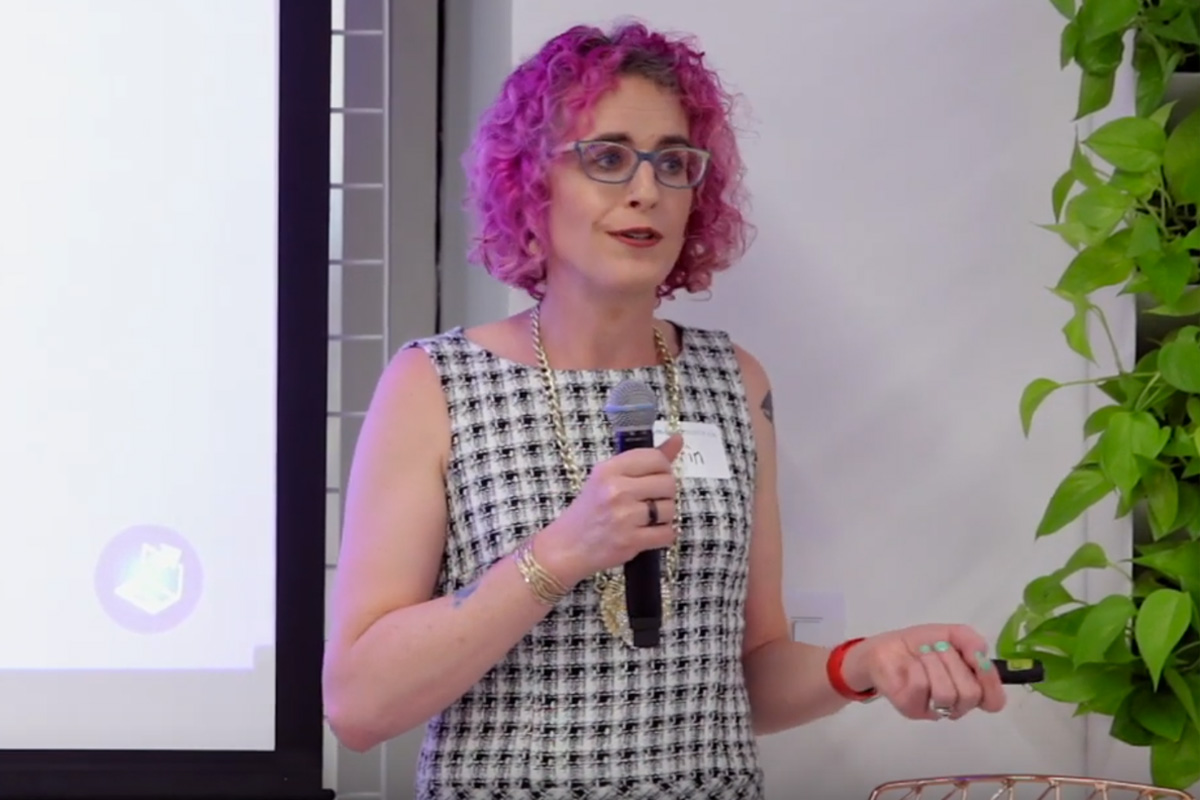
Principal Software Engineer Erin Dees gives a talk on “Dossiers of Awesome: One Way to Help Folks Get the Recognition They Deserve” at Stitch Fix Girl Geek Dinner.
Erin Dees: Hi friends, how are you all? One more talk on the theme of partnership before we all get some networking time. The focus here now is going to kind of narrow in on the personal partnership, because as strong women we are told that we need to lift one another up. But how? Now part of the answer lies in helping our peers get the recognition and the visibility that they’ve earned.
Erin Dees: It’s about giving meaningful feedback that lifts them up, and also helps you. So this talk will be … The title, Dossiers of Awesome, is just a way to frame these habits and practices. It is not a complete solution to how to lift one another up. It is not a universal recipe. It’s an idea. What I’m really hoping with sharing it, is I get to hear your ideas afterwards. So let’s talk during networking time.
Erin Dees: My name is Erin. I joined Stitch Fix about two months ago as a principal engineer. These are my goats, it’s the day I brought them home in my Kia.
Lila Bowker: I’m so sorry, we’re having … Try this one. I don’t know, I’ve mixed up which one was the good one.
Erin Dees: Can everybody hear me now? Is this better?
Lila Bowker: Is that better?
Erin Dees: Okay.
Erin Dees: Thank you, friend, sorry about that. All right. You didn’t miss anything. Something, something goats. All right. Okay. I really enjoy working on a big thorny systems engineering problems, the kind where you have to reach out across teams, learn from industry, learn from one another, and then package that learning up and bring it back to your team. That’s my jam, like sharing knowledge like that. That’s why I write programming books. That’s why I coach athletes how to race walk faster. It’s not why I have goats, but they are very good listeners.
Erin Dees: This talk came out of a conversation that I had with a former colleague, Liz Abinante, a few years ago. We were talking about this series of stories we’d read, prominent women leaving their posts in the tech industry because of being passed over for opportunities, and being harassed. I said to Liz, “How do I get better at observing, at noticing? I would hate to think that something like this happened to somebody on my team, and I didn’t even see it. How do I catch this happening?”
Erin Dees: And Liz said, “People aren’t going to harass in front of an audience. Right? They’re not going to harass in front of witnesses. So, that’s not the way. If you want to help your teammates, that’s not really a great way to do it.” And I said, “Well, how do I help my teammates? Half my teammates are women, how do I … I like them, I like working with them, how do I hang onto them?”
Erin Dees: And Liz said, “Help them get the visibility and the recognition that they have earned.” The conversation branched out from there, we brainstormed a lot. But I want to pause here for a second, and say that even though this idea came out of a difficult situation and a tough conversation, it’s going to apply in a lot of different scenarios, and I also am aware that a lot of the people in this room are already doing a lot of emotional labor for their teams. The last thing I want to do is give you all more homework.
Erin Dees: I really want to talk about this in terms that will help you in your careers as well. How many of us are in a job where we are expected to give feedback on our peers regularly? Right. A lot of us, right. How many people kind of dread that time of year when you’ve got to go write a bunch of peer performance reports, right? It’s exhausting. It takes forever to write, and by the time you’ve done your fourth or fifth one, it’s hard to come up with something that is unique that could only apply to that engineer.
Erin Dees: Like, “Well, you’ve built some great products for us, and keep learning more advanced Ruby skills, I guess.” Like I mean, right, that could apply to everybody. So how do we get feedback that helps that specific person get better in their career? And that’s what we’re going to talk about. So in order to achieve this goal, whatever process we adopt should be lightweight, because we’re all busy and we’re just not going to do it if it’s too much of a burden on our time.
Erin Dees: It should be something that we keep up with in little increments throughout the year, instead of having a big deadline dropped on us. And again, it should be actionable, it should give our peers information that they can use to grow their career. One idea had been sitting right in front of me this whole time, which is an engineering journal. Now, I had started keeping this a few months prior, because we had formed a brand new team, and there was so much learning for all of us, that we really had to capture what we’d learned and what we’d done in some way, and my solution was to keep a journal.
Erin Dees: I tried to do it every day, ended up doing about 50% of days, and here’s something like what that looked like. 4:30 p.m. every day right before the end of the workday, a blank window pops up on my desktop, it’s time to write in your journal. And I spent just a few seconds, literally just a few seconds typing in a couple of bullet points. I implemented this feature. I fixed some tests. It’s okay to get snarky, it’s your own journal. Nobody’s going to read it. And the twist here then, was to realize that there’s no reason I couldn’t put anybody else’s accomplishments in here.
Erin Dees: Sometimes my journals talked about stuff I’d done with my teammates, but it was time to get systematic about it, and use hashtags and stuff. And so that’s what I started doing. So in addition to what I’d worked on, I might add a couple of bullet points that a teammate worked on, and tagged them with a hashtag, which comes in handy later. So then if you’re in a culture that does sort of quarterly feedback cycles, when it comes time to do this, I can click on that person’s tag in my journaling software.
Erin Dees: This is totally real data you all. I did not just type a bunch of this stuff at 1:00 a.m. in my hotel room last night. So then you can either copy and paste, or kind of paraphrase, but you start with a blank document, and you can paste all this data in here. And you start to notice as you do this that these items kind of fall into patterns. These few items seem like they’re about incident response. These couple of items here seem like they’re about tech leadership, and so you can group them. You can start moving them around and you can add some headings.
Erin Dees: Now, then what you do with this information depends a lot about your feedback culture. If you’re in a place where you’re expected to write your own review, for starters, a self-review, you can give your peers the ammo, the raw material that they can use to write their self-review. So here’s what that might look like, you can compose an email, and if your manager is someone who’s supportive, write it to them and Cc your friend or your peer. Well, I hope they might be your friend too. And this now tells them a story. If they’ve been waiting for a great opportunity to write a promotion pitch for this engineer, you’ve just given them all this ammo.
Erin Dees: But the audience is also your peer, because if they’re going to be writing their self-review, it’s going to be a bunch of stuff that they may not remember in the moment that they accomplished that quarter. That said, though, do please let the manager know what they’ve done as well, because there’s a lot of cultural pressure on us not to brag, and we should fix that too. But if this is all stuff that happened, this isn’t bragging. It’s data.
Erin Dees: It’s a good idea to share it with … again, if you have the supportive manager, and with your peer. So how to make this feedback actionable, so that somebody can act on it and grow their career? One way to do this is to work these data points into a story, so it’s not just data, it’s a narrative. What this looks like, for example, if you start noticing this person developing or showing an aptitude and interest in tech leadership, is to call that out, and say, “Hey, maybe it’s time to start handing this engineer larger projects and have them run bigger initiatives. They seem to have a knack for it.”
Erin Dees: So I want to pause, just one second, and say that we’re at a women’s conference, and we’re talking through this originally through the lens of a conversation about women in tech, but there are lots of teammates that we have that are dealing with other marginalized identities, some multiple marginalized identities. So I want us to keep in mind all of our teammates who might be marginalized along one or more axes when we think about lifting one another up.
Erin Dees: That is one way that we can have an impact on our careers and our peer’s careers, is lifting them up. But again, this helps us do our jobs better. If we’re expected to give feedback, and we can do something that gives better and high quality feedback more quickly with less overhead, that helps us too. That makes us recognized for giving good feedback that really helps people, and that’s the impact I’m hoping that you all will have, no matter how you all choose to do it.
Erin Dees: So I’m really grateful to Girl Geek and Stitch Fix for putting together this event. Lila, this has been amazing. I love it. I have loved every talk I’ve watched. The other presenters, you all are amazing. I’m really grateful to Liz Abinante for this original conversation, and Lila and Miriam for helping me, appropriately enough, with meaningful actionable feedback about this very presentation.
Erin Dees: As we prepare to head into networking time, I want to come back to that cultural expectation that we don’t brag, and I want to chip away at that just a little bit tonight. I’d like to invite you all, as you’re introducing yourself to other people, to say something that you’re awesome at, work related, non work related, doesn’t matter. Lead off with something you’re skilled at. And if that’s one notch too extroverted for the comfort level tonight, maybe ask the person what they’re awesome at. Just know that they might turn around and ask you, be prepared for that, it’s okay.
Erin Dees: As we were brainstorming for how to lead into networking time, as a group of presenters, Lila brought up these two articles about the importance of owning your awesome, of owning what you’ve built. I really want to embody that spirit tonight, if at all we possibly can. It’s been hugely inspiring to be in this room full of awesome badass women in tech. I’m really grateful to be up here. I hope you all have a great rest of the event, and cheers.
Erin Boyle: Thanks, Erin. That was amazing, thanks, Erin.
Audience Member: I have a question about the buying process, like particularly more like the supply chain issues you might face. How do you, if you end up with an extra load of clothes that don’t fit anybody, how do you steer away from trying to push product on people just to sell it, and what do you do with your unsold inventory?
Anna Schneider: Yeah. There are several algorithms that help with that, unsurprisingly. So, yeah, we have clearance algorithms that figure out, hey, this thing isn’t performing very well, and then sometimes we will get rid of it through donating it, so that’s one common way that low performing stuff will leave our inventory. Although when we’re doing that, we do want to make sure that we’re not getting rid of stuff that’s like bad for a lot of people, but like really good for someone. We do want to keep that niche stuff around.
Anna Schneider: So with the client’s expectation, like I was talking about, like that’s like something that we’re always trying to figure out how to get better at.
Cathy Polinsky: But I think one of the things that I really appreciate about Stitch Fix is that we separate out the merchandising team who buys the product from the stylist team that sends the product to the right people. So we have intentionally created this firewall between the two, so the stylists are never incented to send bad product out to their clients.
Cathy Polinsky: They don’t know, “Hey, we’ve got a lot of those lime-green shoes out there that aren’t selling, can you just send it out to people.” Instead, we really try to make sure that the stylists are incented to really keep their clients happy, and if we buy bad product, we eat the cost ourselves, and learn from it for the next time, to make sure that we don’t make the same mistake over and over again.
Cathy Polinsky: It is this interesting system where sometimes actually getting rid of bad product helps everybody else up, just making sure that that bad product is not inadvertently getting into Fixes. And so we’ve seen these times where we have changed the dynamics in the model, of how often we’ve gotten rid of bad product, and we’ve now learned that it’s not a good idea to hold onto it, but it’s much better for us to get fresh stuff in. Was a good question, though.
Lila Bowker: Nice. All right. I’m getting my cardio in, you guys, hang on. There you go.
Audience Member: Hi, I’ve a question with respect to recommendations. How do you deal with surprise, because you can learn someone’s style, but often when someone really, really likes something, it might be because it’s a little bit outside their comfort zone, and it’s one item. Do you like work that in by humans or algorithms?
Erin Boyle: Yeah. That’s a great question. And I should say that the exact answer to that might change, depending on what context you’re talking about. So, probably you’re asking about in someone’s Fix, and in that case a lot of that would be done by the human stylist. We do have algorithms that try to think about assortment, but we mostly rely on stylists, or … Yeah? Yeah, stylists would definitely be injecting a lot of that.
Erin Boyle: The other thing I’ll say is another place where you might use recommendations, I mean we have recommendations everywhere, but another place you might use them is like in the stylish level itself. Of course there are recommendations that are fed back to the client, and certainly there is some like assortment logic and experiments and stuff that have gone into like injecting surprise into that experience too.
Cathy Polinsky: But we try to get employees to style, as well as the stylist, and so I try to style a couple Fixes a month, and occasionally I’ll get someone that says, “Stop sending me skinny jeans,” and the recommendations only knows that this client buys skinny jeans, and so the stylist has to think of like, “Well, maybe I’ll send her a boyfriend jean, or a boot cut jean.”
Cathy Polinsky: Our algorithms have no idea what they’re going to want next, based on their previous purchases, but we’ll have to use this … we like to call it the blend of humans and machines. The art and science of what we do is sometimes there is this kind of stylistic creativity that goes into generating a Fix. It’s kind of fun.
Erin Boyle: Well said.
Bingrui Tang: I was also going to add on that, because sometimes there will be clients say, “Oh, I really don’t wear dresses,” and then all of a sudden they’ll say, “Oh, I’m going to a wedding, then I need a dress.” So it’s very important for us, when we design the system, we really keep in mind this kind of flexibility, and people’s preference will change, either occasionally or over time, and we really want to recognize that. I think that’s a really good question, and that’s definitely the fun part of the work, is trying to juggle them both. Yeah.
Lila Bowker: All right, let’s start here.
Audience Member: The question is about the buying process in the old traditional way. One of the reason they’re using that method is because probably the cost optimization, the more you buy, the cheaper it is. But buying optimized by diversity using algorithm, how you deal with the cost optimization to the supplier?
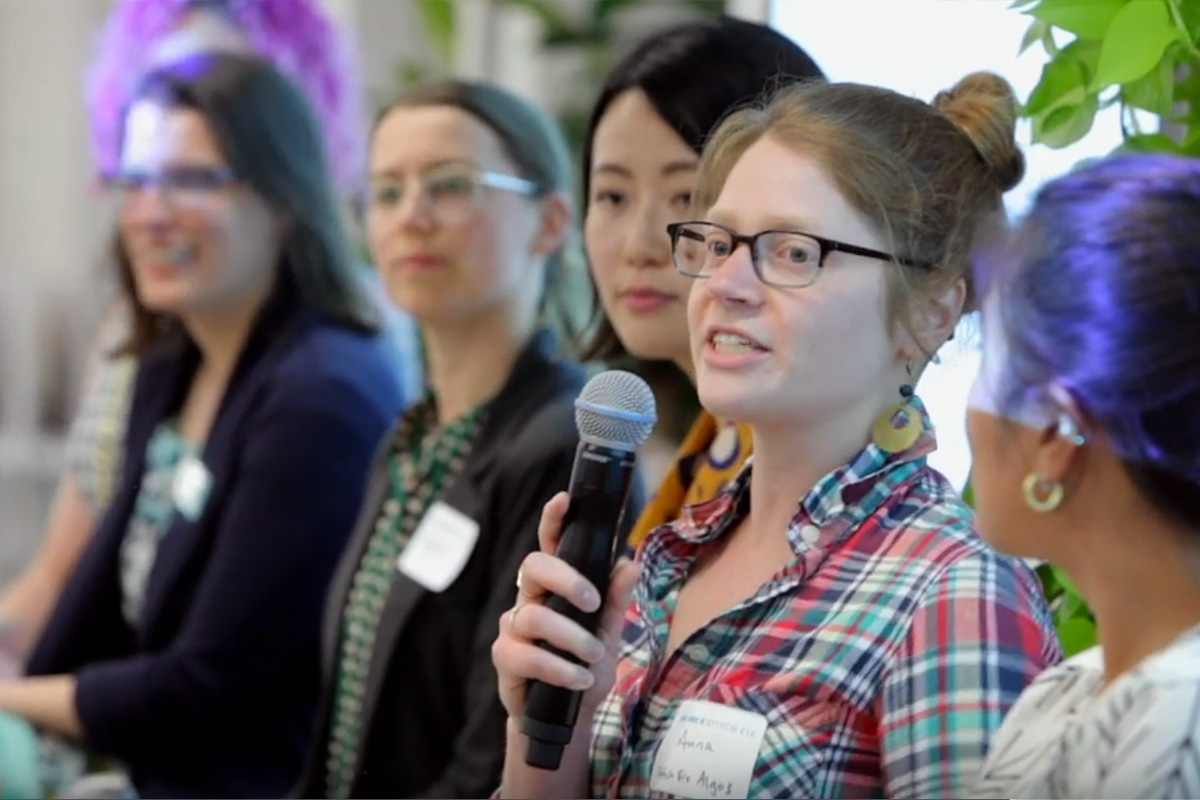
Stitch Fix girl geeks: Cathy Polinsky, Erin Boyle, Bingrui Tang, Anna Schneider and Emma Colner answering audience questions at Stitch Fix Girl Geek Dinner.
Anna Schneider: Yeah, so in the constraints that the buyers will put into the problem, one of them is exactly around that. We know how much we’re going to buy it at wholesale, and we know what our margins will be because of that, and often the algorithm will say like, “Hey, this one has really good margin, buy even deeper into it.” So if that’s something that we want to be … Yeah, yeah, it’s something that’s just rolled into all of our other data.
Anna Schneider: That’s something that we … Margin isn’t the only thing we care about by any means, there’s all these other metrics about making the experience really right for the clients, and so that’s what we are … currently it’s formulated, where we’re trying to give the best experience to the clients as possible, constrained by having a profitable business. Yeah. So the client is really first.
Audience Member: Sure. One of the things I’ve always struggled with with these try before you buy services, is that the things I like aesthetically don’t always match the things that look good on me. I’m curious what you guys think about that, and how you are imagining how the Stitch Fix product addresses that challenge?
Erin Boyle: Yeah. I mean that’s a tough question. I think there is kind of a fine line between aesthetic and fit. I mean even in this latent style data, which we think of as being largely a style thing, like people are rating whether they like an item and it’s a very visual thing, they’re not necessarily seeing the size of that item that they would actually buy, or the can’t tell the inseam or whatever.
Erin Boyle: And yet we do see fit preferences coming out of that data, like we can figure out some fit preferences too. Yeah, I mean I think we certainly try to collect information on both style and fit in the style profile, and through other means, and then certainly the client has a conversation ongoing with the stylist, where they give the stylist feedback on the details of what does and doesn’t work for them.
Erin Boyle: And then those kind of like subtler pieces of feedback that really take a human to interpret can be acted on by that stylist.
Cathy Polinsky: Anecdotally, I see this. I have some clients that have an Instagram feed, and I’m like, “Oh, they liked this item, we have it in inventory, I’m going to send it to them, even though the match score is really low for the product.” And I send it to them and they hate it, but I’m like, “You said you wanted it.” But there is this notion of what they like stylistically, versus what is good on them, and so I’m really impressed with how these match scores that we have factor that into the recommendations.
Cathy Polinsky: And it’s not like, “I don’t want that navy blazer, I want a navy blazer that looks good on me.” And so how can we take the style things that people are sending us, and pair that with other factors, like fit, to find the exact right thing for you. It’s a hard problem, and that’s why it’s so much of a pain for people to try to shop online and scroll through lists and lists of jeans, to figure out what’s going to fit them.
Cathy Polinsky: So I think that this is a different model that we can use, that can factor in a lot of those different attributes.
Audience Member: I found it really refreshing to see multiple senior female engineers on this panel, and I was wondering what your approach was to sourcing and retaining female engineers. Sort of like what percentages of your teams are female, with regard to engineering specifically? And did that change as Stitch Fix got larger?
Cathy Polinsky: We are really fortunate for the gender representation that we have at Stitch Fix. It helps that we have a female CEO and founder, Katrina Lake, who has started this company. Half of our leadership team is women, more than half of our board is women, and a huge representation of our stylists are women, so if you look at our employee count, which is predominantly stylists, it’s over 80% women who work at Stitch Fix.
Cathy Polinsky: And then our technology organization is really strongly represented. We’re in the high 30s for representation of women in our tech organization. It’s still not 50/50, and still opportunity for us to grow, but compared to every other tech company that I’ve worked at, we are really leading the pack at having a very strong gender diversity in our teams.
Cathy Polinsky: We hadn’t done it through top down quotas or mandates, but really it was generated by teams and managers who cared about this. Of understanding that diverse teams build better products, that we had primarily women as our clients, and to really understand them and understand the products that we’re building, having those diverse teams helps us to make sure that the things that we’re building are really strong and supporting that client base.
Cathy Polinsky: What was great for me to see, as we were scaling out our organization, it’s hard when you’re hiring fast, to make sure that you’re thinking about diversity and all of the different criteria, but we only got better as we scaled. It really came down to the managers who didn’t have that diversity on their teams, were asking the other managers who were doing well, like, “How did you do that?” And, “How can I do that?”
Cathy Polinsky: It came through inclusive language in our job postings, or thinking about sourcing in a different way. We talked about experiences that we had to make sure that we had diverse panels, and then we also look for really product centric engineers at Stitch Fix, and I think that that helps us generate a more diverse pipeline of what an engineer looks like throughout our organization.
Cathy Polinsky: We’re not done. We still really want to hire more architect level senior individual contributors here at Stitch Fix, that’s an area that we don’t have as much diversity. And then we’re also looking to increase our racial diversity, and think that we are really leading the way on gender diversity, but have some more way to go in other aspects of diversity, like racial diversity.
Cathy Polinsky: But I love that we’re a group that cares about this, and we talk about it, and we celebrate where we are doing well, and also understanding that we’re not done.
Erin Dees: May I jump in for a second?
Cathy Polinsky: Yeah.
Erin Dees: I joined pretty recently, and it was one of the things that drew me to Stitch Fix, was seeing that there were so many women in engineering specifically, and then as you look up, senior leadership, in terms of like management, there’s a lot of women in senior management as well. That was something that really shines through, so one reason I think that Stitch Fix has so many women in engineering, is because we’re drawn here. We see like, this is a good place for me. None of us wants to be the only woman on the team, so it’s been awesome.
Cathy Polinsky: Great. Thank you. Glad to have you.
Lila Bowker: Another question over here.
Audience Member: Hi. I have a question on I guess the outlook on how accurate you think your algorithms are becoming over time? Are they becoming more predictive? Do you think that we’ll get to a point where the algorithm can handle both the strategy and the tactics? And if we are at that point, do you think that Stitch Fix would ever move to a model where maybe there is less reliance on human stylists? If yes, why? If not, why?
Erin Boyle: I’ll let Anna speak to the strategy tactics, because that’s definitely your framing. I will say they’re definitely improving all the time. Obviously we can’t give you any quantification of that, but I’ve actually been here almost four years, and it’s shocking how much better we are. You can see it in so many ways. So, yes, they’re improving all the time. I still expect them to improve more, but I don’t expect it to really change anything about the role that people are playing.
Erin Boyle: I think that the role our stylists play is always going to be critical. It’s a critical part of our business model, they play a critical role, and similarly with our merchandising partners, and so many other people, so yeah, I’ll let Anna speak to the strategy and tactics. But that would be my reaction to that.
Anna Schneider: Yeah, one analogy that we’ve started using for the strategy versus tactics, is are we building a self-driving car, or are we building something like Google Maps? I’m mean for a self-driving car that’s just like all about the tactics. It’s like … can be completely automated. There’s no human in the loop there, whereas something like Google Maps, it doesn’t even make sense to think about what that would mean if it was fully automated, because who’s telling it where to go? You need someone giving the instruction.
Anna Schneider: And so there’s always going to be that company leadership and leadership at levels all throughout the company saying, “Where are we going?” And that’s always going to be a human decision, and so we think of it almost more like a scenario exploration engine, where you can say, “Hey, what if we went in this direction? What if we went in this direction?” And then the humans have the opportunity to choose what of all possible futures we want to be going after, and that’s always going to be a human touch.
Cathy Polinsky: So any chess players in the room? Yeah. Was it Kasparov who was the chess player who lost against Deep Blue? So we look at the sense of … At that time it was like this is the end of chess, and the age of the machine, and machines are going to always be better than humans, and what was it? So that was when the first chess game played against a human and won.
Cathy Polinsky: But what’s interesting is after that point, there was a new emerging game that was this freestyle chess. Have you guys heard of freestyle chess? So the freestyle chess, is this idea that it doesn’t matter whether you’re human, or you’re a computer, or a blend of the two, but anybody can play against anyone.
Cathy Polinsky: So they have this competition every year and there’s a freestyle likeness, and the first year that they did this a novice group of chess players won using computers, and they did it in a very novel way, of using a suite of machines to solve the problem. It was this really interesting thing, it was the blend of humans and machines. Humans that had an interesting approach for how to solve the problem, but they were backed by computers.
Cathy Polinsky: And so we use this likeness of what Stitch Fix does. It’s not computers alone, it’s not stylists alone, but it’s this blend of humans and machines that work together in a novel way, to solve a problem in a unique situation. And so we feel really strongly about this model and how it’s helped us, and sometimes we’ll lean a little bit more on the machine side, sometimes we’ll lean a little bit more on the human side, but regardless of where that line is, we feel like the power of the two together is really a magical thing.
Lila Bowker: Awesome. We do want to leave enough time for folks to chat afterwards and brag about themselves and hear what makes everyone else awesome, so maybe one more question, is that all right with you guys? All right, here you go.
Audience Member: Hi, sorry, one of the last questions. A lot of fashion is traditionally geared for women, so I was wondering if you have seen patterns that are maybe encouraging males to be a little more adventurous in their stylistic choices? Just out of curiosity, you know, I think … I mean, I don’t know, but personally I have brothers, that I would like them to be more adventurous, and it’s hard to get them into the space.
Audience Member: I don’t know if you have encountered patterns or had strategies, or even have some vision for even working with fashion industry to sort of expand, that fashion’s not just for women, but also for people who traditionally are not associated with fashion?
Cathy Polinsky: We started out as a women’s only business, and for the first five and a half years we only had women clients, and then about two, two and a half years ago, we launched our men’s business. It’s been really great to see that business growing and thriving. I’d say, I don’t know if it’s specific to gender or not, but we see some clients that start out and they have a specific sense of what they’re looking for, and as they use a stylist, over time, they get to be more adventuresome. And they might try new things and get some of these serendipitous things in their Fixes that they never would have picked off of a rack before, and try it on.
Cathy Polinsky: You know, we see this with our women clients, but I think we see it a little bit more so with our male clients. And I think that that is just kind of a fun thing about our service, is that something that you might never try on, something that you may see in a Fix, we don’t even show you what’s coming, because we don’t want it to taint your view of the Fix before it arrives at your doorstep. And sometimes there’s something that you never would have like wanted in your Fix, that you try on, and I’ve had this happen to me as well, that I’m like, “Oh, this looks amazing.”
Cathy Polinsky: And so I think that that aspect of discovery is a really amazing part of our service, that it works for those folks that may be stuck in their style, whether you’re guys, stuck in a rut, or even a gal, yourself. And so it’s kind of a fun part of our surprise and delayed-esque model. I hope I answered that.
Lila Bowker: Bing had a client recently that was awesome. Bing, you should tell that story.
Bingrui Tang: Oh, yeah.
Lila Bowker: Remember your client?
Bingrui Tang: Yeah. So I had a client who is probably in his 40s and 50s, and I got his first Fix, and he said, “Oh, yeah, so my style is a little bit conservative, really boring, but I want to make my wife happy, so I really want to stretch it out a little bit.” This is his first Fix, and he such high expectation, so I’m really nervous, and I share it with the team, I say, “Yeah, what do you guys recommend?”
Bingrui Tang: And somebody actually recommended a conversational piece, which is essentially pink flamingo prints. Yeah, and zebra prints, and things like that. So I actually sent a bunch of them to him for the first Fix. He returned all of them. I think I definitely went too far, but he said, “Thank you for all the pieces you sent, I think it’s a little too stretched for me, but I really get idea, and I really want to try it again.”
Bingrui Tang: And he actually immediately scheduled another Fix, and so assigned me as his stylist. So for the second Fix, because now I know where he would be more comfortable with, I actually pulled back a little it, and I think he kept all of the five pieces. Yeah, so I think, back to your point, I really think, yes, I’ve sent many, many pink shirts to male clients, and a lot of them end up keeping them, so I think, yes, the discovery part is really the fun part.
Lila Bowker: Awesome. Well I think we want to open it up so everybody has the time to chat and brag about themselves, and hear what makes everyone else awesome. The quick plug of, of course, we are hiring. If you work at Stitch Fix, can you raise your hand? Everybody who works at Stitch Fix, stand up and raise your hand. Yeah, so if you want to chat more about the roles we have open, aim for one of those human beings that just raised their hands.
Lila Bowker: But I’m excited to get to know more of you better. Enjoy. Yeah, and thanks for coming.
Our mission-aligned Girl Geek X partners are hiring!


